LIFECYCLE
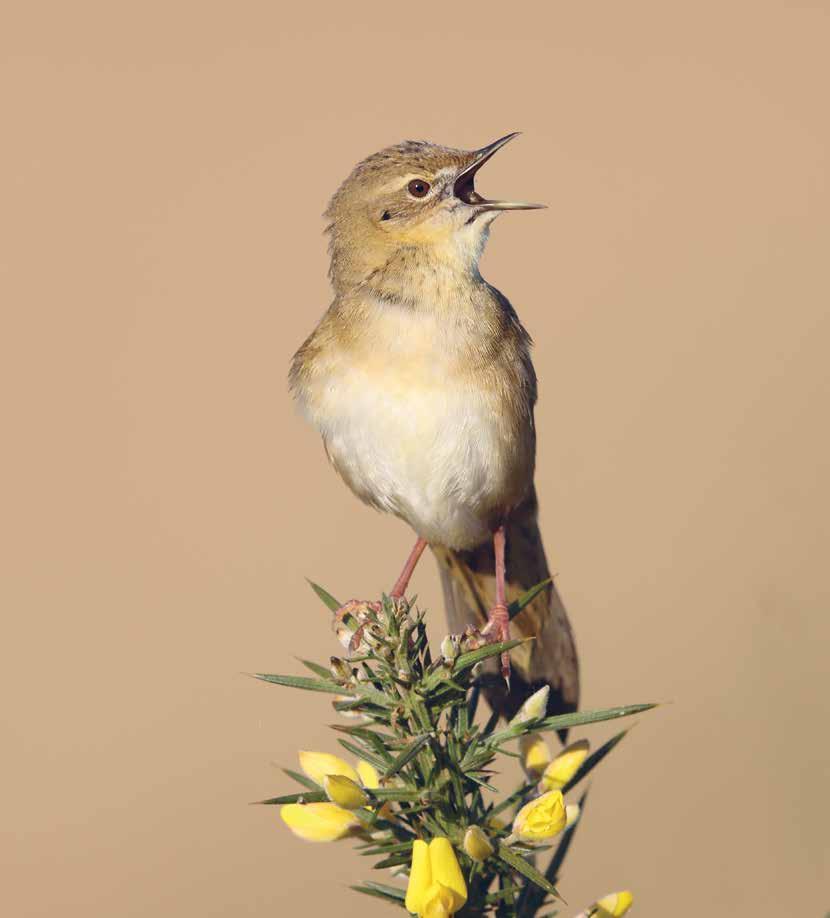
Grasshopper Warbler
Nest-finding tips
Editorial ISSUE 15 SUMMER 2025

Welcome to the summer edition of LifeCycle. This spring has been the warmest on record, as well as being incredibly sunny and dry. Whilst this has probably meant good conditions for ringing and nest recording for most of you reading this, what effect it will have had on our breeding birds remains to be seen.
In this edition, we have articles focusing on monitoring Linnets (page 12) and nest recording Grasshopper Warblers (page 16). If you have ever caught a Water Rail and struggled to age or sex it, the guide on page 7 should help. And if you were wondering why you saw more Siskins in your garden in 2024, the article on page 4 reveals all. This edition also contains two new series of articles. The first highlights how different ringing or nest-recording groups function, with this edition featuring the newly formed North Cornwall Bird Ringing Group (page 14). If you would like to write about your group for a future edition, please get in touch. The second series shares stories from the network of bird observatories, starting with the Calf of Man and Alderney (page 20).
We also bring you articles on CES (page 10), RAS (page 19), studying Whooper Swans (page 22) and ringing migrants (page 21). We introduce you to your new RIN members on page 26 and explain how the modular permit system is working, one year after launch (page 24). All that plus some fascinating snippets on pages 11 and 27.
As ever, we extend our huge thanks to everyone who has contributed to this edition. Please do contact us if you have an idea for a future article.
LIFECYCLE
THE BTO MAGAZINE FOR RINGERS AND NEST RECORDERS
The Ringing and Nest Record schemes are funded by a partnership of the BTO and the JNCC on behalf of the statutory nature conservation bodies (Natural England, Natural Resources Wales, NatureScot and the Department of Agriculture, Environment and Rural Affairs, Northern Ireland). Ringing is also funded by The National Parks and Wildlife Service (Ireland) and the ringers themselves. The BTO's contribution to the Ringing Scheme is supported by funding from Gifts in Wills, for which we are extremely grateful. The BTO supports ringing and nest recording for scientific purposes and is licensed by the statutory nature conservation bodies to permit bird ringing and some aspects of nest recording. All activities described are undertaken with appropriate licences and following codes of conduct designed to ensure the welfare of birds and their nests is not adversely affected.
CONTACT US
The British Trust for Ornithology is a charity dedicated to researching birds. For membership details please contact: membership@bto.org
British Trust for Ornithology, The Nunnery, Thetford, Norfolk IP24 2PU Tel: (01842) 750050 Website: www.bto.org Email: ringing@bto.org, nrs@bto.org, ces@bto.org, ras@bto.org
Registered Charity no 216652 (England & Wales), no SC039193 (Scotland)
LIFECYCLE PRODUCTION
LifeCycle is the biannual magazine of the BTO Ringing and Nest Record schemes. It is freely available on the BTO website.
Articles in LifeCycle are written by ringers and nest recorders, so please send ideas and contributions to the editors: Lee Barber — email: nrs@bto.org Ruth Walker — email: ruth.walker@bto.org
Editorial board: Ruth Walker, Lee Barber, Mark Grantham, Ros Green, Peter Kirmond, Joe Morris, Justin Walker and Ellie Leech.
Layout, design, imagesetting and typesetting: Ruth Walker and Mike Toms.
Printing: Micropress Printers Ltd www.micropress.co.uk
Thanks to the proofreaders for all their efforts. Cover image: Grasshopper Warbler, by Charles Tyler The views expressed by the contributors to this magazine are not necessarily those of the Editors, the Board of the BTO or its committees. Quotations should carry a full acknowledgement. © BTO 2025
NEWS FROM RINGING & NEST RECORDING
BIRD ATLAS 2027–31
BTO is delighted to confirm that we are in the early planning stages for the Bird Atlas 2027–31. Many ringers and nest recorders will have contributed to previous Atlases, either directly by collecting records on one or more survey squares, or indirectly through the inclusion of some of the breeding evidence data you collect through ringing and nest recording. Thank you to everyone who has contributed to past Atlases – we hope many of you will also be interested in contributing to this new one, fieldwork for which commences on 1 November 2027. We look forward to sharing more details about this exciting project with you over the coming years.
BECOMING (MORE) INCLUSIVE
BTO has recently launched a new video about our Becoming (More) Inclusive work. The video highlights in a playful way the narrative behind the work we are doing collectively at BTO in order to become more inclusive; breaking down barriers and creating more opportunities for people who we aren’t
yet engaging with. We will of course continue to celebrate the achievements of our existing community of staff, volunteers, members and supporters. We hope your key takeaway from the video is that we all have a common goal that is to achieve the greatest impact for birds, which cannot happen without the passion and dedication of our brilliant staff and volunteers! You can find more information about our Becoming (More) Inclusive work on our website, which includes a section for frequently asked questions, and you can watch the video at: www.bto.org/ inclusivity
OPERATION OWL
Despite the legal protection they receive, some of our bird species continue to be persecuted. The Police National Wildlife Crime Unit has launched a national initiative, ‘Operation Owl’, to tackle illegal persecution. You can support this campaign by being alert to suspicious activity, such as the use of illegal pole traps and poisoned baits. If you spot

something illegal or suspicious, report it to the police. If the suspected crime is taking place right now, call 999 immediately. Never approach suspects yourself as they may react violently. If the suspected crime is no longer taking place, please use the national police non-emergency number 101. When you are connected to the police, ask to speak to a Wildlife Crime Officer. You can find out more about the campaign on the National Wildlife Crime Unit website: www.nwcu.police.uk
On the morning of 1 April I loaded the very last of the IPMR submissions received the previous evening. Having worked at the BTO for just over 28 years, this seemed quite a momentous day to me and gave me pause for thought on all the changes I’ve seen during that time.
How we got to where we are now:
• 1983 – Working group set up and provisional coding scheme published
• 1986 – B-RING launched and used to submit computer-printed schedules to the BTO
• 1995 – BTO moved to an ORACLE relational database to store ringing and recovery data, and started to accept ringing data
electronically via floppy discs (remember those?)
• 1998 – Win-Ring released; a Windows based program to handle, report and analyse B-RING data files
• 1999 – Integrated Population Monitoring Reporter (IPMR), written by volunteer Mark Cubitt, launched
• 2000 – The retirement of B-RING
• 2009 – IPMR used by over 95% of BTO ringers to submit all their ringing, retrap and recovery records
• 2014 – BTO Ringing and Recovery database restructured
• 2018 – Launch of Demography Online (DemOn)
I would like to take this opportunity to thank all the ringers
and nest recorders, some of whom will have used all of these systems, for your commitment to embracing the technology, without which the Ringing & Nest Record Schemes could not continue to operate sustainably. We particularly appreciate your patience during DemOn’s prolonged development, especially those of you with whom we are still working to resolve the last issues with the transfer of locations and data from the previous system. We have come a long way, and IPMR has played a significant role in getting us there, so we’d like to offer a huge thanks to Mark Cubitt for making this happen, as we enter a new phase of the BTO Ringing & Nest Recording Scheme.
Bridget Griffin
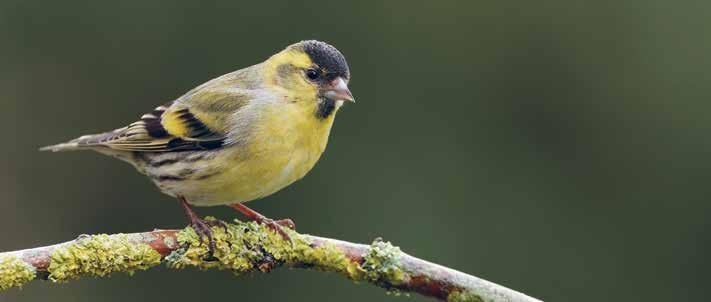
Siskin is one species that is currently thriving, having undergone a quite substantial range and population increase across Britain and Europe over the past 50 years, and this trend looks set to continue.
The great Siskin influx of 2024
The Siskin is a widespread breeding bird across much of Europe and Asia, where it is typically associated with upland and northern conifer forests in the summer. During winter, a larger portion of the northern British and Continental populations migrate south or west, respectively, to winter across southern and central Europe. In this article, Greg Conway from Thetford Forest Ringing Group examines the exceptional influx of Siskins to our shores in 2024.
In Britain and Ireland, the wintering population is made up of a mix of migrants from the north and east of Europe, as well as some resident and short-distance migrants and, to add to the mix, others pass through on their way to southern Europe. As the winter diet is still comprised of cone seed, most birds head to areas of wet woodland where alder seeds are the favoured food source. As these become depleted towards spring, they switch to birch and larch but, much to the ringers’ delight, they also turn to supplementary food in gardens and other ringing sites. Siskin are a regular feature of many gardens, particularly near woodland, through March and April, but numbers and occurrence vary considerably from year to year. This is mainly determined by the availability of natural food (cone seed crops vary in abundance every two to four years) and how many migrate. When food is abundant they remain closer to breeding sites, but they will migrate considerable distances when food is scarce.
MIGRATION AND RINGING
Even though tens of thousands pass through Britain and Ireland during the autumn
they are very tricky to catch, as they rarely respond to sound lures, unlike Redpoll, and mostly prefer natural food sources. The best ringing options usually come in the form of drinking sites, which can be very productive when birds are moving. In late winter and spring, however, they turn into voracious hordes that exhaust one food source after another, quite literally like clouds of green locusts!
Just before they start to migrate back to the north or east, they need to accumulate large amounts of fat to make the rapid and long-distance migration back to their breeding sites. At this time, garden feeders are like magnets where they feed with urgency. During peak passage weeks, there can be hundreds moving through each hour for days and days. On three consecutive days, around 100 were ringed each morning by Thetford Forest Ringing Group at a single site and only one was retrapped – the following day.
During dry periods, water can be a better catching source than food. The best catching at feeders often occurs following a period of rain or on damp misty days, as during these conditions the moisture
makes the alder and conifer cones close up, locking away their seeds and forcing the birds to search elsewhere.
It’s interesting to see how the pulses of migration are heavily linked to the weather, with birds departing ahead of an incoming weather front. The biggest catches usually coincide with fine weather when there is a massive, broad-front migration and where you can see a constant movement of small to larger flocks continuously drifting through at treetop level.
HOW EXCEPTIONAL WAS 2024?
Data from Garden Birdwatch highlights 2024 as being the third best Siskin year since the scheme started in 2003, only exceeded by 2006 and 2013, and BirdTrack showed that the reporting rate in early 2024 was 50% greater than the historical average. From a ringers’ perspective, 2024 saw the highest annual ringing total in Britain and Ireland with over 63,000 new birds ringed (Figure 1), not including all the subsequent encounters! This eclipsed the previous best ringed total of 46,000 achieved in 2013.
WHERE DID THEY COME FROM?
Each winter a large portion of the breeding population from across northern Britain and Ireland migrate to southern Britain, as well as lower altitudes for the winter. In winter, southern Britain is a total mixing pot, with wintering birds from the north and also from central and northern Europe, as well as passage birds moving further south, as far as Spain, plus plenty of local resident birds. This makes it very difficult to infer the origin of a bird caught in winter or spring as local resident birds will be nesting from mid-March, with chicks emerging in early April, while Scandinavian migrants may not have even departed until late May. Ringing recoveries are therefore extremely helpful, but despite over 60,000 caught and around 9,000 subsequent encounters during 2024, very few movements link both breeding and wintering sites.
We looked at recapture records to help reveal the actual and likely origins of the birds seen across Britain and Ireland last winter. These were restricted to birds that were present in Britain and Ireland during winter (November 2023 to February 2024)
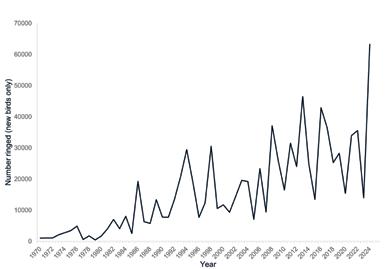
and that had moved more than 20 km. To determine where birds originated, we looked at individuals that had been ringed during a summer or autumn prior to 2024 and their locations when recaptured. To determine where our birds went, we examined recovery data for birds ringed in Britain and Ireland in winter 2023/24 that were subsequently recaptured during spring and summer 2024. These figures alone highlighted the big disparity between numbers caught here in autumn (n=72) versus spring (n=923).
In most winters, the majority of foreign recoveries involve the Low Countries, with fewer from Scandinavia; however, in 2024 the pattern was reversed (Figure 2a), with the majority emanating from Fennoscandia and a third from central Europe. This indicates that the exceptional numbers were the result of a substantial long-distance movement from Fennoscandia.
THETFORD FOREST FINDINGS
2024 was also one of the most prolific years since long-term, standardised Siskin ringing commenced 25 years ago. The Thetford Forest subsequent encounter data in 2024 nicely illustrate the distinctly different patterns of movement that are obscured by the sheer number of records for Britain and Ireland. Even though the majority of movements involve birds mid-migration, where the breeding and wintering destinations aren’t known, ringing data can provide some big pointers as to where they are heading. Looking at the exodus of birds departing in early 2024, and arrivals
ACKNOWLEDGEMENTS
Thanks to all the BTO ringers for generating so many Siskin captures and for data provided by Thetford Forest Ringing Group who are supported by P&R Seeds.
caught while passing through Thetford Forest (Figure 2b), they originate from wintering sites throughout Britain and are heading east to make the short sea crossing back to the near Continent and beyond. The spring departures, involving wintering birds and active migrants (Figure 2c), clearly show the division between regular movement of birds back to upland breeding sites, in Scotland in particular, but also the long-distance movements to, or even through, Scandinavia and Finland. Birds recovered in the North Sea more likely travel up through Scotland before traversing the North Sea, rather than making a direct flight.
WHY WAS 2024 SO DIFFERENT?
The vast numbers caught at supplementary feeders during February to April 2024 suggests that there was a shortage of natural food during the 2023/24 winter; however, the 2023 autumn passage was unexceptional, being below average, suggesting that the large numbers encountered had arrived later in the winter. Also, despite the numbers caught it was quite clear that the vast majority were unringed, suggesting that they had originated from populations where little ringing was undertaken, in contrast to Britain and Ireland where around 2–3% of birds caught are already ringed.
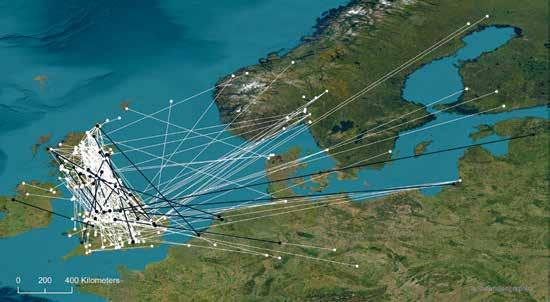
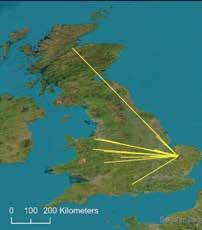
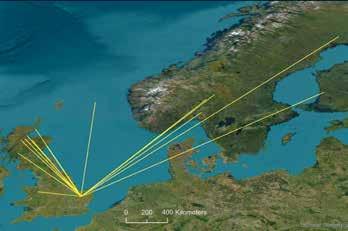
Figure 2a: Siskins re-encountered in Britain and Ireland during winter 2023/24 (movements to, from and within Britain and Ireland, >20 km only). White lines show winter/spring to summer movements; black lines show summer/autumn to winter movements. Figure 2b: origins of Siskins moving to Thetford Forest during winter 2023/24 (movements >20 km only). Figure 2c: Siskins caught in Thetford Forest in winter 2023/24 and reencountered elsewhere in spring or summer 2024 (movements >20 km only).
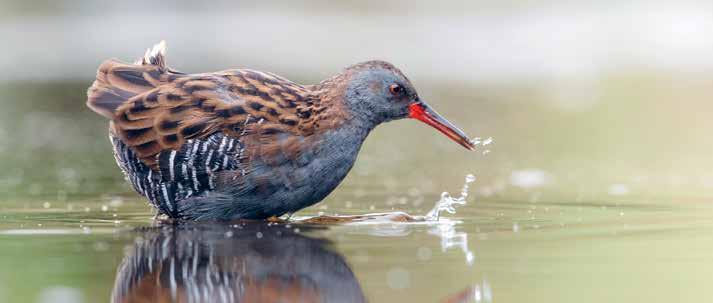
Ageing and sexing Water Rails
Over the last 10 years, Derek Robertson has been ringing good numbers of Water Rails in the extensive reedbeds on the River Tay in east-central Scotland. He has regularly recorded over 100 captures in a year, which has generated a lot of retraps, allowing comparison of known-age birds. The following is a summary of Derek’s thoughts and findings on ageing and sexing Water Rails.
My study has focused on trapping birds between March and May but has also generated scores of captures between November and February and a handful of captures between June and October. These notes should be read alongside the accounts in Baker (2016) and in Demongin (2016) from where I have sourced the biometrics.
SEXING
Male Water Rails are larger than females and a good proportion can be sexed using biometrics: wing (max chord), bill (to feather) and tarsus (minimum, per ‘Svensson’). There is, however, considerable overlap and birds from different populations (so possibly different sizes) are migrating between locations, so exercise caution (ed: and please ensure the sexing method field in DemOn is filled in).
Various authors state that most birds can be sexed using a combination of biometrics but my experience is that very many birds in the overlap for wing are also of intermediate size in bill and tarsus. That said, Baker states that the majority can be sexed as follows:
• Male = wing >122, bill >41, tarsus >42
• Female = Wing <120, bill <40, tarsus <40
Demongin says that while this works for most, biometrics for some means that only wing <116, bill <39 and tarsus <38 will exclude most males. As a result, I exercise caution in sexing birds in the following ranges unless plumage, bill and eye colour all support that conclusion: wing 116–123, bill 37–41, tarsus 39–41. Water Rail do not develop brood patches so that doesn’t help to determine sex. Catching both birds of a pair on breeding territory can be useful, but note that birds range between territories so I would want to have repeated captures of the pair before concluding sex using comparison between them (assuming larger, brighter male and smaller, duller female).
MOULT
Adults undergo a complete post-breeding moult, with Tay birds probably completing between September and mid-October. Juveniles undergo a partial post-juvenile moult, with Tay birds completing this between September and December.
AGEING NOVEMBER TO JANUARY
Earlier in the autumn/winter, birds in juvenile plumage are easily identified
REFERENCES
Baker, J.K. 2016. Identification Guide to European Non-passerines. British Trust for Ornithology, Thetford. Demongin, L. 2016. Identification Guide to Birds in the Hand. Laurent Demongin, privately published.
Svensson, L. 2023. Identification Guide to European Passerines. Lullula Förlag, Stockholm.
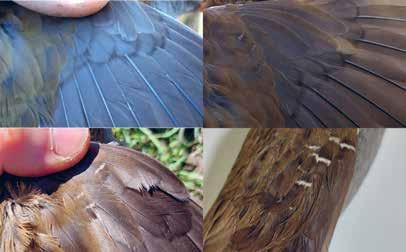
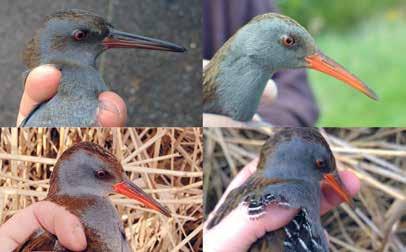
by extensive brown, juvenile feathers. Comparison of juvenile primaries is useful until late October, by which point I find wear of both adults and juveniles are too similar to use. Feathers are quickly abraded on birds wriggling through dense reeds.
Birds retaining juvenile plumage can be easily distinguished by brown feathers on head, neck and sometimes on chest or belly. If juvenile feathers are retained, then they have a pale, cream-white chin, whereas this is pure white in adults.
As post-juvenile moult progresses and the bird replaces all these feathers with adult-type, the head feathers are the last to remain, especially the brown line of feathers above the lores contrasting with slate-blue adult feathers. As the winter continues, most juveniles replace the majority of contour feathers and look identical to adults so you need to start using more comparative criteria.
AGEING FEBRUARY TO MAY
By now, most birds have a fully adult appearance (although some juveniles will still have a brown stripe of old feathers above the lores) but if you are able to sex a bird using biometrics, or age it using the ring number or retained juvenile plumage, you may be able to work out age or sex using the following criteria. These are comparative and highly variable so you need to inspect a few birds to gauge what the differences are and be careful to weigh up all the criteria. There is a lot of individual

Slate-blue on chest, black-and-white barring on flanks. Brown fringes to barring and chest. From left to right: 6F, 5F (intermediate), 5F (typical), 6M, 5M (intermediate), 5M (typical). NMS Z.[2003].[203].[1] NMS Z.[2003].[24].[2] NMS Z.[1934].[61].[2189] NMS Z.[1966].[19].[26] NMS Z.[1932]. [21].[30] NMS Z.[1893].[82].[70]
variation and often they are not conclusive, so many birds are impossible to age or sex; however, the basis is that brighter and more striking colour and contrast is more apparent in adults than immatures and more apparent in males than females.
• Bill and eye – redder in males than females and also redder in adults than immatures.
• Chin – the extent of white on the chin is not useful at this time of year in my experience.
• Primary wear is not useful at this time of year in my experience.
• Slate-blue on face and chest – darker and more blue in colour in males than females and darker and more blue in colour in adults than immatures.
• Brown on chest, flanks and thighs – brown or buff fringes to barred feathers on belly or flanks and on slate-blue feathers on chest is less of a feature in males than females and in adults than immatures. Note: these fringes wear off as the season progresses so an individual showing this feature in January will be less apparent in May.
• Barring on flanks and thighs – wider white bars extending further up flanks is more obvious in males than females and more obvious in adults than immatures.
• Black on face and lores – more prominent on males than females and more prominent on adults than immatures.
• White barring on primary coverts (PCs) and median coverts (MCs) –more prominent on males than females and on adults than immatures. There is usually none visible on MCs or PCs of immature females. Typically appears as thin bars on MCs on immature males and adult females and more strongly on MCs (occasionally also slightly on PCs) of adult males (although very variable).
Of the above, I find the extent of black on lores and face, barring on thighs and barring on coverts to be the most useful. I use eye and bill colours to corroborate this and the slate-blue colour of face and chest,
together with brown fringes on thighs and flanks, as supporting criteria.
Note that I stop trapping by the end of the first week in May because I want to avoid trapping dependent chicks and their attendant adults – the first chicks appear in the Tay Reedbeds around 9 May.
ACKNOWLEDGEMENTS
Thanks to The National Museums of Scotland for allowing me access to inspect and photograph their collection of Water Rails and to Dr Martin Stervander, Senior Curator of Birds for assisting me in inspecting the collection. Photos from their collection used in figures list the collection reference code.
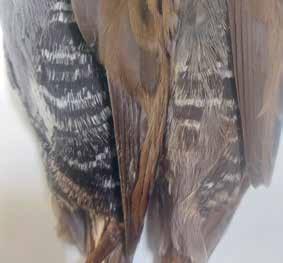
Flanks. Left 6F, right 5F. NMS Z.[1953].[183].[95] NMS Z.[2003].[24].[2]
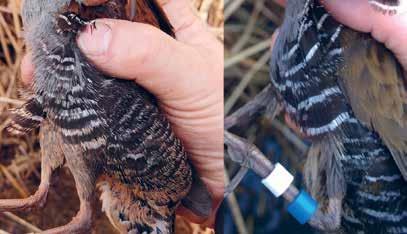
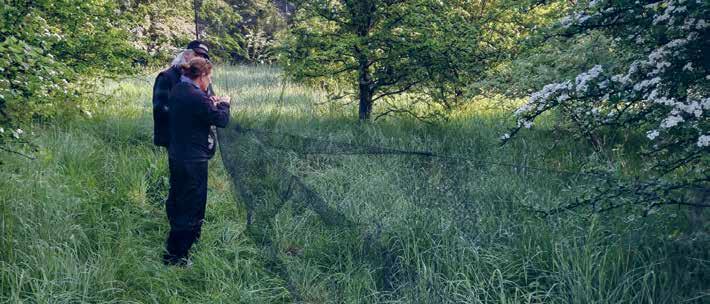
The first year of a new CES
Since early in his ringing career, the Constant Effort Sites (CES) scheme has been the project in which Jacob Davies has been most motivated to participate. Helping out on others’ CE Sites showed him that running a CES could be a rewarding and fascinating experience, and analysing CES data during his PhD and in later work showed him its special value for science. So it was with excitement that he and others from Tay RG set out on a chilly April morning to make the first CES visit to their new site.
Our CE Site, in Clackmannanshire, is a small triangle of open hawthorn woodland, rough grassland and bramble, tucked in between a wetland nature reserve on the River Forth and a vast area of warehouses for storing whisky barrels before they’re shipped around the world. My Trainer, Jeroen, had already ringed at this site for a few years in all seasons, and together we’d discussed the various ways in which, beyond being a good general ringing site, it could also make an ideal CES. Most importantly, previous years showed that the site produced good catches of birds in the breeding season. The site is close to home or workplaces for many of us that might ring there. It is also no bad thing that there is Water Mint to forage, and that Giant Hogweed hasn’t colonised yet!
HOW SHOULD WE RUN OUR SESSIONS?
Having decided that we were going to run it as a CES, the next thing to decide was our strategy – how many nets would we use and when would we start and end our sessions? We wanted to get our strategy right in the first year because CES requires a lot of effort and it’d be a shame to have to change
strategy in the second year and make the first year’s data unusable.
The first consideration was that we had to catch enough birds that it could qualify as a CE Site. Luckily, Jeroen had run several sessions at this site during the breeding season in a previous year, so we worked out that a particular combination of nets should capture at least the target 200–300 birds over the season.
The second consideration was that the site had to be manageable with the smallest team we were likely to be able to draw on. CE Sites are most valuable when they run for at least five years; even though people will come and go, there is a large enough pool of keen local ringers to run our site as a CES for a while yet. Even so, not everyone is available for every session, and many of us who ring around here are often busy at the same time, so the site had to be as small as possible in case only one or two folk were available for a session.
Finally, we could boost team size by making CES more attractive! More people are likely to come along if they don’t have to be sleep-deprived at work, take half a day’s leave, or forgo going away for the weekend.
We therefore tried to start as late as possible and keep sessions as short as possible. To try to balance these factors, we decided to run 96 m of nets from 06:40 to 10:40, which should be manageable with our smallest available team, and from which we’d expect at least 300 birds in a typical year.
OUR FIRST CES SEASON
2024 was not a typical year! Our inaugural year was one of the poorest breeding seasons in recent years. It was a cold, wet spring and birds did not return or failed to breed. Often the site was quiet, and nets were empty, round after round. We stayed optimistic, hoping that it was just delayed, or that captures would pick up later in the season as birds moved around. But when visit 10 in early August yielded just seven birds, we knew we weren’t going to hit 200–300 unique captures. Despite our pre-season calculations we only caught 118 birds.
But any gloominess from the low catches was far outweighed by the fascinating experience of running the CES over the season. Each visit feels different, as birds busy themselves first with courtship and territorial battles, then breeding, and then dispersal, moult and departure. Different species dominate the catches each time. As
the visits tick on, we get glimpses into the worlds of the birds in whose way we place our nets. The young Willow Warbler caught in the same net in consecutive visits, staying close to its natal site while it started its postjuvenile moult. The pulse of Sedge Warblers in July as they ranged more widely from the nearby reedbed.
CES also gave us insight into the nature of the breeding failures, which varied between species. Willow Warbler alone had a highly productive season, while the lack of juvenile tits accorded with the dire breeding season at our nest-box site a few miles away. An adult Sedge Warbler we caught in early June just gave up breeding early on: it was controlled in a Brittany reedbed in late July, when in an ordinary year it may still have been feeding its second brood.
I went into the season mostly motivated to carry out CES due to wanting to contribute: because I believe that CES is just such a valuable dataset for understanding why our bird populations are changing. But I hadn’t expected the process itself to be so absorbing. As I write this, it’s only six weeks until the CES season starts again, and I can’t wait to see what turns up. I’d encourage ringers considering setting up a new CE site to give it a go!
May the fourth be with you!
Following an influx of Red-footed Falcons into the UK this spring, Justin Zantboer shares another unusual arrival from the east.
Trimley Marshes were acquired in 1990 by the Suffolk Wildlife Trust and along with my two children, Ellie and Dan, we’ve ringed there since 2014. Ringing and birding at Trimley had been quiet the previous week and May 4th 2025 was no different.
Dan and I arrived on site at 04:15 to open our six nets and by 07:30 had only ringed two birds, so with the sun shining and the breeze increasing, we decided to pack up after the next net round. Arriving at our ‘rarities net’,
we were surprised to see two birds caught. I extracted a retrap Sedge Warbler, leaving Dan with a Reed Warbler. Moments later, Dan started swearing: “Dad, it’s a control and is by far the best one we’ve ever had at Trimley! BUDAPEST!” It took a moment to register what he’d said, and already my birding brain was going into overload! How and why was there a Reed Warbler from Hungary here?!
We processed the bird, took a few pictures and released it, then phoned Rob Duncan who’d trained us all. Like us, he was totally blown away and after having a quick check on the database, he couldn’t find any records of any

passerines ever being controlled from Hungary, so confirmed what we were already thinking, that this was the first Reed Warbler control from Hungary. Editors’ note: HGB.P683423 was ringed as a first-year bird at the Földvári Lake Bird Ringing Station in southern Hungary on 25 July 2024. It is only the second Hungarian-ringed passerine to be found in Britain & Ireland, following a Sand Martin caught in Lincolnshire in 2008.
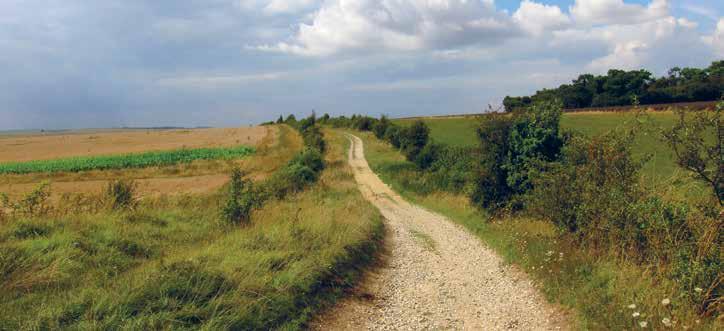
Looking for Linnets
The Linnet is found over most of Europe, except in central and northern Fennoscandia, and its range extends to northwest Africa and northwest China. Although widely distributed across Britain and Ireland, Linnet declines between the late 1960s and 1980s mean the species is on the UK Birds of Conservation Concern Red List. In this article, Niall Burton , Raymond Duncan , Chris Jones and Ron Louch share their knowledge of monitoring this charismatic passerine.
The British breeding population of Linnets is partially migratory, with some birds spending the winter in Britain and others moving south or southwest to winter in France, Spain or Morocco (Wernham et al. 2002).
Linnets on the west coast of Wales are predominantly migratory; big influxes, that quickly pass through, are seen in late March and are not seen again until the same time the following year.
Linnets feed mainly on small to medium-sized seeds and, unlike most finches, the young are fed entirely on seeds, both ripe and unripe (Newton 1967), which are ground into a paste by the adults. Cuckoos will occasionally lay eggs in Linnet nests but, due to this seed diet, their chicks don’t survive.
HABITAT PREFERENCES
Linnets breed in a variety of habitats including rough common land, heathland, restock forest, golf courses and farmland hedgerows. Nests are usually located below 2 m in height, in dense bushes or hedgerows, often just under the canopy. They will nest
preferentially in gorse, but will also use brambles, young conifers where vegetation is growing up through the low branches and will even (occasionally) nest on the ground in grass, rush tussocks or heather. Linnets can be semicolonial, with birds nesting in groups of bushes relatively close together, so searching likely habitat in areas where birds congregate is effective.
NEST FINDING
Linnets are a double-brooded (occasionally triple-brooded) species, with the core breeding season spanning April to July. During the building and incubation stage, males will sing from a conspicuous post directly above, or near, the nest. As with other finches, pairs often visit the area of the nest together when building, so nests can be found then by looking at likely bushes in those areas. Females with big balls of sheep’s wool in their beaks are particularly easy to spot during the nest-lining stage. Males may also accompany females returning to eggs, sometimes feeding the female off the nest beforehand.
Linnets can be sensitive to disturbance during the egg-laying period and are likely to desert if disturbed during this period. When females are on eggs, tapping all gorse bushes lightly with a stick in the hope of flushing sitting females is a very successful technique for finding nests. Although Linnets can be quite synchronised, they are never all at the same stage, so nest visits should be timed carefully.
RINGING PULLI
Linnet pulli have short legs, so (as with all birds) timing of ringing visits should ensure that they are old enough to take a ring, but not so big that they might not settle back into the nest. The pulli ringing window is therefore relatively short, but ringing at the IP (in pin) or FS (feathers short) stage is probably best.
CATCHING ADULTS
Linnets are particularly easy to catch in a whoosh net. You can pretty much forget all the usual cunning fieldcraft suggestions in the way of dummy poles
and elastics, camouflaging the net, and so on; Linnets are very easy-going (or stupid?) and will happily come to a site regularly baited with rapeseed, regardless of whether the catching equipment is in place or not, as long as there is a suitable perch such as a fence line or bushes in close proximity. It is not unusual to find birds that you encountered earlier in a session returning to the bait site within a couple of hours. A site that catches the morning sun is preferable; while most ringing takes place in the few hours after sunrise, it is also possible to get acceptable catches in mid-to-late afternoon.
Any site near to where Linnets are known to breed should work. Coastal strips or upland areas with gorse are particularly favoured in the breeding season; birds will travel for distances of at least 1 km to a known source of food (Newton 1972).
Linnets travel in flocks in winter, so good numbers can be attracted to reliable food sources. In winter it’s a matter of identifying a favoured feeding area, normally a weedy stubble or turnip/swede field, and establishing a feeding site along the edge.
For further guidance on whoosh netting, see LifeCycle Issue 6.
SEXING LINNETS
Be aware that some full-grown males never show any red in their plumage, unlike in southern Europe, and initially,
they may be assessed as female in the hand (see photograph below). Attention to the other sexually dimorphic features (buff or brown scallops rather than streaks in upper breast, chestnut mantle and lesser coverts, plus same extent of white in wing as juveniles) should allow sexing of most birds, but maybe three or four out of a thousand are so tricky that they have to be left unsexed.
Sexing of juveniles post-fledging is straightforward using the published criterion of extent of white at the root of the inner primaries, although about 2–3% of juveniles are ambiguous and best left unsexed.
AGEING LINNETS
Ageing as 3 or 5 according to the presence of a moult limit in the greater coverts is reliable in post-juvenile birds, with this feature still clearly visible in a good proportion of age 5 birds through to April or May at least. Some firstbrood birds, however, will moult all their greater coverts and some late-fledging birds may moult none or only one or two, so the moult limit in the greater coverts can be almost anywhere, or nowhere.
The two outer greater coverts can look a bit different to the rest of the greater coverts even when known to be of the same generation, so exercise care when you are tempted to age a bird on the basis of one or two unmoulted greater coverts. Tail-feather shape is
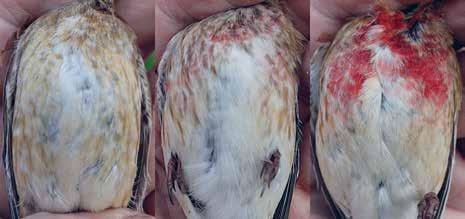
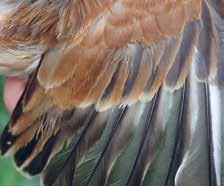




also pretty reliable: at least a tail with rounded tips on all feathers in the spring is a good indicator of age 6, and one that’s very worn and pointed suggests age 5. Primary-covert shape and quality can be a useful supporting feature. Post-juvenile moult of the alula feathers can be just plain confusing however! As always, every bird should be assessed according to all the available features and any anomaly accounted for; otherwise a non-committal age class should always be assigned. The chart in Jenni & Winkler (2020) showing likelihood of each feather being replaced during post-juvenile moult appears to be accurate for British birds.
REFERENCES
Jenni, L. & Winkler, R. 2020. Moult and ageing of European passerines. Bloomsbury Publishing. Newton, I. 1967. The adaptive radiation and feeding ecology of some British finches. Ibis 109: 33–96. Newton, I. 1972. Finches. Collins, London. Wernham, C.V. et al. (eds). 2002. The Migration Atlas: movements of the birds of Britain and Ireland. T. & A.D. Poyser, London.
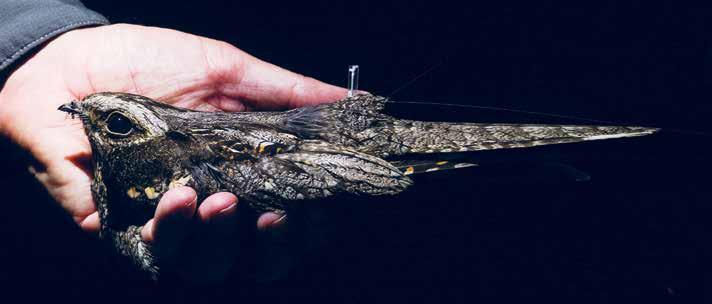
Ringing together
When Pete Roseveare first considered establishing the North Cornwall Bird Ringing Group (NCBRG), it was driven by a dual purpose: to create a dedicated hub for local ringers and to enhance the credibility and impact of their collective project efforts, contributing to both national and local research. What began as occasional assistance from a handful of local bird enthusiasts gradually developed into a committed team eager to take a more active and formal role.
As interest grew, it became clear that formalising our efforts would not only enhance the quality and quantity of our work but also encourage greater recognition and support from external organisations. Establishing an official group (in January 2024) allowed us to pool expertise, share responsibilities more effectively and take on moreambitious projects with collective commitment. We are now a structured team, focused on collecting high-quality ringing data by conducting local-scale studies to support wider national schemes and, most importantly, conservation efforts.
THE MOTIVATION BEHIND THE GROUP
The primary driver for forming the group was the recognition of a lack of structured bird-ringing efforts in North Cornwall before the group’s formation. Whilst I personally had undertaken ringing activities in the area for years, much of it was fragmented, with no coordinated effort to bring together a team that could systematically monitor bird populations in a meaningful
manner. I envisioned a group that would not only contribute to national schemes but also focus on specific local species and habitats that were underresearched.
Another significant motivator was the importance of training and mentorship. Bird ringing requires intensive skill development and gaining experience can be challenging without structured guidance in a supportive environment. Looking back, establishing this environment was made easier by the diversity within our founding members, spanning different ages and genders. This diversity naturally provided an inclusive space where prospective trainees could find someone relatable to connect with when starting out.
However, as the demographic of our new trainees has now shifted to predominantly younger females in their 20s, it became increasingly evident that traditional approaches, such as inviting individuals to remote locations at 4 am, were not always practical or welcoming! The wider discussion around the
experiences of some trainees in the field reinforced the need to rethink how opportunities were offered.
My goal in forming the group was to create a structured and supportive space where aspiring ringers could refine their skills with guidance from experienced mentors. By doing so, we not only ensure proper training but also cultivate a welcoming and inclusive community for future ringers.
THE WORK OF THE NCBRG
Since its formation, the NCBRG has expanded its efforts across a wide range of projects, strengthening our understanding of local species populations and contributing valuable data to national schemes.
One of our most established projects is the Constant Effort Site (CES) on Goss Moor, which existed before the group’s formation but has significantly benefited from a larger, more coordinated team. By sharing responsibilities, we have improved efficiency, ensuring consistent data collection despite weather
disruptions or individual availability. To complement this, we have also introduced a Winter Ringing Project site, providing year-round monitoring and more ringing opportunities for the members more active in the winter.
Our group has played a key role in local Willow Tit conservation efforts through an intensive colour-ringing study, tracking the movements, survival and habitat use of this rapidly declining species. The use of camera traps has enhanced our ability to monitor individuals without requiring frequent recapture. In collaboration with the RENEW Partnership, the University of Exeter and Cornwall Birds, this project has expanded from a small-scale effort into a major research project, with the potential to inform national conservation strategies.
Dippers have long been a focus for some of our members, and we are in the early stages of establishing a Retrapping Adults for Survival (RAS) project in North Cornwall. This initiative aims to track breeding success, survival rates and movements along our local river systems. Whilst still in its infancy, the project has already generated interest from a local university, which is looking to run a study alongside it, exploring the relationship between breeding Dippers and Grey Wagtails.
One of our most ambitious projects has been the GPS tagging of Nightjars on Bodmin Moor, undertaken in collaboration with researchers from Dorset Nightjar Group. By tracking these elusive birds, we aim to gain a deeper understanding of their local habitat use, foraging behaviour and territorial movements. The data collected so far has already revealed fascinating insights into their nocturnal foraging habits, roosting preferences and even some unexpected behaviours, including potential mate prospecting in other territories.
Beyond these structured studies, we also support West Cornwall Ringing Group by monitoring 50 Barn Owl boxes that were originally covered by them. This work has provided valuable
data on breeding success and has helped some of our newer members gain experience in monitoring cavitynesting species. Additionally, some of our trainees have begun developing their skills in open nests, which we hope to expand further this coming season.
Another recent and exciting development has been the monitoring of migrant birds at our coastal site at Porth Joke during the spring and autumn. This has provided new opportunities to track the movements of species using Cornwall’s coastline as a migration corridor, adding to our understanding of how birds use the region throughout the year and allowing us to encounter the occasional interesting vagrant, such as a juvenile Red-backed Shrike last autumn.
THE VALUE OF A RINGING GROUP
Setting up NCBRG has transformed bird ringing in the region, making it more structured, efficient and sustainable. A team-based approach allows for better coordination, shared responsibilities and increased capacity, ensuring that long-term monitoring projects can be maintained with consistency. Beyond improving efficiency, the group has created a supportive environment for training and development, making it easier for new ringers to gain experience and progress towards their own permits. It has also fostered collaborations with researchers and institutions, enabling us to undertake more-ambitious studies and contribute to wider ornithological research.
A major advantage of formalising our efforts has been securing financial support. By using social media, we have showcased our work, built engagement and attracted funding from individuals and organisations who value our research. This has allowed us to invest in better equipment, support trainee development and expand our monitoring capabilities beyond what would have been possible through personal contributions alone.
Another major benefit has been the positive impact on mental well-being. Frequently sharing ringing experiences with a like-minded team fosters a strong sense of camaraderie. The group provides a space where members can enjoy their passion in good company, work towards common personal or professional goals and take a break from daily stresses. Whether it’s an early morning ringing session or a long-term research project, the social and personal rewards of working as a team are just as valuable as the scientific outcomes.
For Trainers working with a small team, establishing a ringing group can be a transformative step in birdmonitoring efforts. The ability to collaborate, mentor and support each other not only enhances the quality and consistency of data collection but also fosters a sense of community and shared purpose. Beyond the technical skills gained, the camaraderie and encouragement within a dedicated team make the experience more enjoyable and rewarding – both professionally and personally. The collective effort, passion and shared success of a ringing group truly make a lasting impact.
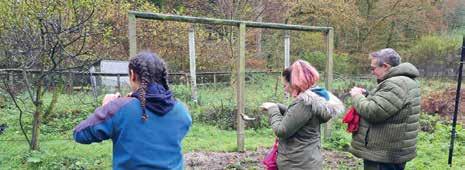
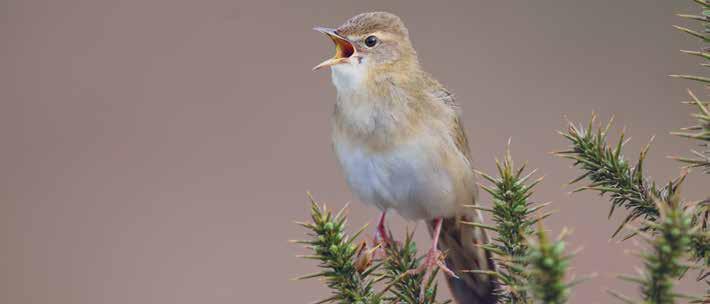
There are only around 800 nest records for Grasshopper Warbler in the NRS database, so more would be very welcome.
Deep in Juncus
People ask, how do you find bird nests that vary from a Meadow Pipit in an open expanse to a Crossbill in a tall, dark pinewood? Seasoned nest recorders will likely say the same thing; watch the bird. Nest finding centres around patience and perseverance. In this article, Jim Shortridge (AKA Juncus Jim) shares his journey of discovery over the last six years seeking out one of the most difficult-to-find bird nests, that of the Grasshopper Warbler.
Once you know your bird species, you learn the signals they give for where their nest is located. For Skylarks this might include the outpouring of its beautiful song as it lifts into the sky, or for the Reed Bunting, the male slipping down a grass stem as the female appears from the vegetation below when a nest changeover takes place. Signs and signals learnt from hours of dedicated observation!
This is all well and good when you can watch the bird, but what if you cannot even see the bird? This is the story of a bird that often breeds deep in tall grass or Juncus (rushes). An elusive bird that flies all the way from Africa to breed here in the UK, but is not easily seen on its nesting grounds. Even after many hours of watching you may be none the wiser that the birds are even there at all.
FINDING TERRITORIES
Arriving from their wintering grounds in early April, male Grasshopper Warblers make their presence known by their continual reeling ‘grasshopper-like’ song. Their point of arrival is a good time to assess the number of pairs within your chosen
study area. But equally, at this time males can wander far and wide across song posts until they find a female and a territory is established. Some males stop singing when nest building commences, but others may sing up until the last egg is laid. In my experience, a good indication that the laying of a clutch is under way is when the male sings for a few hours in the early morning but then stops, around 8.15 to 8.45 am, as he goes to relieve the female on the nest to allow her to feed. Once the clutch is complete, singing tends to stop altogether. Nest building is seldom witnessed, and I presume this is because much is done without flight. On a few occasions, I have observed nest material being collected from around the nest area and I have seen both adults help build the nest. The nest can be constructed within as little as four days, and it is built at any time during the day.
NEST-FINDING TECHNIQUES
Trawling through the old literature on nestfinding techniques for Grasshopper Warbler, it suggests walking swiftly through suitable habitat with a stick, tapping in the hope of seeing a bird leaving the nest. This can
sometimes be productive; however, the birds will often slip off the nest before you are upon it, with the bird showing itself many metres from the actual nest. This is a rather crude approach, which I no longer use. I started my current method accidentally whilst I was out walking a few years ago. I flushed a pair of Grasshopper Warblers just in front of me and for some reason, and I can’t remember why, I was carrying a folding chair, which I opened and sat on to just watch the birds. This is now how I find the majority, if not all, of my nests; by simply watching from a distance, sitting on my folding chair.
But you need patience. You cannot simply turn up at a site and expect to find a nest with ease. Like many other species, Grasshopper Warblers are cautious and especially wary in the vicinity of their nest. Even if you have not seen them, likely as not they will have seen you, and this will switch them into what they are best at –stealth mode – and this makes finding their nest very difficult. Ideally, you need to be around 60 to 80 metres away from the nesting birds in order for them to settle. Then you just watch.
PATIENCE
Again, be prepared to be patient, as finding a nest is going to take time. Indeed, it may take many hours, or even days, to find a nest. But there are ways to improve your chances and speed the process up. Little chinks in their armour can help you locate the nest. A good example of this is during the incubation period as both parent birds share the incubation duty and nest changeovers occur every 30 minutes. This is a highly consistent feature and you can almost set your watch by it.
In the process of a changeover, one bird enters the nest area, then 15 to 20 seconds later, the other bird will leave, usually flying in the opposite direction, and often adopting a long flight to their favoured feeding area. As a bird approaches the nest it can either fly directly to it or approach it in stages. The Grasshopper Warbler is not a bird that you tend to get great views of at the best of times, and these observations tend to be short and fleeting, so vigilance is key to locate the nest site. Nest changeovers
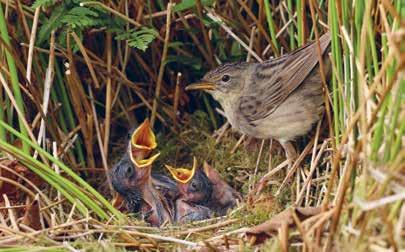
are often missed as birds can also walk to their nests through the undergrowth.
I usually watch around four or five changeover visits before I feel confident enough to go to the nest area to search for the nest. In my study area on Dartmoor there are two main types of vegetation that they choose to nest in – Molinia grass, and Juncus rushes. Nests in Molinia tend to be situated in the top of the tussock, which can be a metre or more high, whilst nests in Juncus tend to be much lower down, even directly on the ground. Nests built in Molinia are constructed entirely of the grass, whilst those built in Juncus tend to be built with rush stems, moss and are lined with grass. Looking at both nests it would be easy to think that they are built by different bird species.
Often it can be difficult to find the nest, even when you have identified the nesting area with accuracy. If I cannot find it quickly, I place a tag high up in the vegetation and repeat the nest-finding strategy, watching again from a distance. Nests earlier in the season tend to be easier to find and, as the foliage thickens through the summer, it can become much harder. In the 2024 season, I trialled the use of thermal binoculars, and this can sometimes help to find the more concealed nests. This method works best in nests with older chicks, with their larger collective thermal output. Some parents of many species give out loud warning calls as you closely approach their nest, which can help to locate it, but this doesn’t tend to be the case for Grasshopper
Warblers, which usually remain silent. They may, however, sometimes alarm quietly as you approach a nest that contains chicks. They are much more vocal once the chicks have fledged.
Like other birds, individuals can show different characteristics and degrees of boldness. In one instance when a nest of chicks was being ringed, the adult female kept trying to return to the nest. We had to place a hand over the nest, to stop her doing so. When the chicks had all been ringed, I watched her immediately settle back on the chicks just feet in front of me; something I might perhaps never see again.
INCUBATION
Incubation of the eggs takes around 13 days and the chicks fledge after 11 or 12 days. As is the case for nests with eggs, nests containing small chicks can be difficult to locate. At this time in the breeding cycle, one parent broods them while the other
Grasshopper Warbler: nest-recording profile
Wide range of open habitats, in both wet and dry settings, common feature being thick (usually tussocky) herbage with scattered bushes or saplings (for song-posts): fens, marshes and margins of wetlands, rough grassland, moorland, heathland, dunes, thickets, hedgerows, young plantations, forest clearings and woodland edges. Solitary.
Site: Usually on or just off ground (typically within 30 cm), well hidden in thick vegetation: often in tussock of grass, sedge or rush; also in brambles, nettles or heather, or in grass growing through base of young conifer or gorse. In wetter settings, wedged deeply into side or top of tussock; in dry, commonly on ground or even sunk in.
Nest: Bulky cup of coarse dry grass, plant stems, leaves and occasionally moss; lined finer grasses and (sometimes) few hairs.
Eggs: White finely speckled with lilac, purplish or purplish-brown, sometimes so thickly that whole shell tinted, but usually densest at big end in form of cap or ring.
Broods: 1-2 (2 in south),
Eggs: 5—6 (3—7), Incubation: 12—13 (—15) days, Hatching to fledging: 11—13 (—15) days.
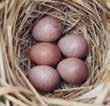
brings in small morsels of food. Two to three visits are made six to eight minutes apart with a subsequent gap of around 20 minutes before this routine starts again. From four days post hatching, both adults bring in food, and this results in morefrequent visits to the nest, occurring every two to four minutes. As the chicks grow, larger foodstuffs are brought to the nest and the visits become even more frequent. This is the easiest time to find a Grasshopper Warbler nest!
On Dartmoor, I have found that most breeding pairs have three broods, with nest building commencing as little as one or two days after the previous nest of chicks have fledged. This interval can be longer, up to five days, but generally nest building starts very quickly after the chicks have left the preceding nest. Depending on the extent of the habitat, second and third nesting attempts can be found as little as 10 metres away from the first, but more generally they tend to be at a distance of around 30 to 40 metres. If a pair loses its nest to predation this distance tends to be greater, at between 70 to 100 metres.
Nest finding requires time and patience, and searching for Grasshopper Warbler nests takes this to the extreme. Much of your time will be spent staring at nothing and waiting for that briefest glimpse of a bird to give those clues you need to find its nest. To date I have found 230 Grasshopper Warbler nests, and spent thousands of hours in doing so. Each year I learn a little bit more about the fascinating breeding biology of this delightful, but rather elusive species.
ACKNOWLEDGEMENTS
I would like to thank the Duchy of Cornwall, landowners and tenant farmers for allowing me access to their land to conduct the survey work. To John Hall for his valued company, and skills in nest finding. To Professor Charles Tyler for his outstanding photographs, his companionship on nesting forays, his pursuit of permissions to help make this all possible, and his support in writing this article. And to my old friend Mark Lawrence, for some great nesting moments, for ringing many of the broods, and for his great help in creating this article.
The ‘BSF’ story
In 2009, not long after Denise CooperKiddle started ringing training, a Starling was netted during a ringing session in Bedfordshire. Denise asked why everyone was so excited and was told the dramatic drop in Starling numbers meant it was quite an event. “ Oh ,” she said, “ I often have flocks of several hundred on my lawn ”. As Denise explains, this led to a longrunning Starling RAS and an amazing collaboration with some neighbours.
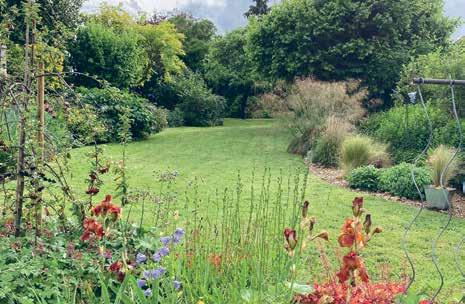
Derek Gruar, my Trainer, seemed somewhat sceptical, so I invited him to come and ‘verify’ my claim. I won’t repeat his exact words when after a 10-minute wait the squadrons descended and the lawn was covered with birds! In January 2010 we mistnetted and ringed the first three Starlings in my garden. In July we began whoosh-netting. By the end of the year 126 Starlings had been ringed in what had by then been nicknamed the BSF (Biggleswade Starling Factory). On 9 May 2025 I ringed the 10,000th BSF Starling!
Starling 10,000 was actually given two rings because, in 2015, I began a Starling RAS. We quickly prepared a leaflet explaining what a RAS was and how to report a sighting of a ringed bird and persuaded local shops selling bird seed and suchlike to put them on their counter. It worked – a few weeks later I was contacted by, and met, a retired couple living a few streets away who’d wondered why some Starlings in their garden were sporting red colour rings. Brian and Viv Hunt immediately took on RAS Starling-sighting almost as a job and began spending a couple of hours most days in their conservatory with a camera, binoculars and a
notebook. Their garden became a new RAS subsite and between 2015 and 2024, they generated just over 39,000 sightings!
Brian was a data systems expert and, as more and more Starlings were (RAS) ringed, we began wondering what other information, apart from adult survival, could be extracted from the sightings if you put the right details in a database. Questions like which sex was most likely to be observed in winter, or was there a noticeable difference in the post-juvenile dispersal rate of first- and second-brood birds? So, Brian built a database.
Unfortunately, Brian died suddenly last November. At the time of his death the database contained the sighting records of over 1,600 RAS-ringed Starlings – a few going back to 2015. To help shed light on some of the dispersal questions, every bird’s record includes not only its sex but the date on which it was given its metal ring. It was also put into one of six categories:
• Totally new – metal and colour rings added together
• Already metal ringed at BSF as 3J in April – June (locally hatched first brood)
• Already metal ringed at BSF as 3J in July – October (local second brood / travelled first brood)
• Already metal ringed at BSF as age 3 or 2 in October – December
• Already metal ringed at BSF as adult
• Already metal ringed elsewhere (control).
Viv is still putting in the hours sighting and I’m still ringing and recording all the details, but not in the ‘convenient’ database. We have a wealth of data that can be shared if this would be of any interest to a student or researcher. If anyone would like to know more about the dataset, please contact Ruth Walker at BTO HQ in the first instance.
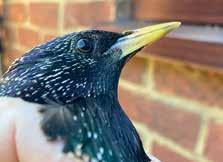
Bird Observatory focus
In the first of a new series of articles spotlighting the work of Bird Observatories, Eleanor Grover, the Ornithological Warden at the Calf of Man BO, highlights the efforts undertaken to recover the island’s breeding population of Manx Shearwaters.
Bird Observatories often garner attention with rarities and stupendous falls of migrants, yet many in the network also conduct dedicated monitoring of the breeding bird populations. On the Calf of Man, a 600-acre island located off the southern tip of the Isle of Man, our seabird colonies are especially important. The eponymous Manx Shearwater was first described on the Calf and, historically, there were thought to be many thousands of breeding pairs; however, the arrival of Brown Rats (known locally as ‘longtails’) from a shipwreck in the 1780s devastated the shearwater population to near-extinction. Longtail control efforts had been sporadic since the inception of the Calf of Man Bird
NEW BEGINNINGS AT ALDERNEY BIRD OBSERVATORY
A challenge faced by all Bird Observatories is how to continue the progress made when a warden moves on to a new appointment. It is harder still when that change is the first time an observatory has faced it. While wishing our first warden John Horton all the best in his appointment at Cape Clear Bird Observatory, Alderney Bird Observatory (ABO) was in new waters after his departure. Happily, our directors and committee recognised the opportunities a new warden could build on after nine great years of achievement. “We need new beginnings!” committee chair Helen McGregor exclaimed. And so it was that after promoting assistant warden Matt Scragg to one of the plum jobs in ornithology, we set about gearing up. Unable to pay a full salary to John, we had been fortunate
Observatory by the Manx Museum and National Trust in 1959, increasing in intensity after the discovery of a handful of breeding pairs of ‘Manxies’ in 2000. The Manx Shearwater Recovery Project was initiated in 2012, when an intensive grid of over 1,000 bait stations was deployed at 50-m intervals. The initial project was a great success, with no presence of rats being detected over long periods. From 147 pairs in 2012, the Manx Shearwater population has now risen to approximately 1,200 pairs. Separated from the Isle of Man by a mere 500-m stretch of water, and with a small rocky islet mid-channel, the Calf of Man is vulnerable to reinfestation by rats, as it is within swimming distance for a determined rodent. Although very low numbers are detected – generally no more than one or two a year – constant vigilance is therefore required through continued surveillance. This monitoring had been undertaken using flavoured wax bait blocks but, more recently, the emphasis has shifted to use of trail cameras located in hotspots around the
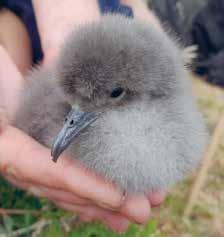
island, and this has proved to be a much more efficient and effective means of detection. Upon discovering any presence of a rat, traps are deployed and monitored daily. While it is a perpetual ongoing battle, it is well worth the effort, for our Manx Shearwaters are continuing to increase in numbers and, not only this, but species like Eider and Wheatear have also benefited – and we hope that Puffin will soon return.
that he was able to find other sources of income, albeit by cutting the hours he spent at the observatory. Now we wanted a full-time warden to cover the migrations and summer nesting period for seabirds.
ABO resources are limited but we have started a fundraising exercise to cover Matt’s salary. We hope to tap into the great desire many companies have, to be seen to be helping nature conservation initiatives. A volunteer has stepped in to help with essential census work through spring and into the summer, while visiting groups of ringers will assist during both migrations and a substantial programme of breeding seabirds. We have a Motus receiver up and running and are looking forward to progressing the project to study Storm Petrel movements, and a grant from
Guernsey’s Social Investment Fund to set up a NocMig (audio nocturnal migration monitoring – eds) project will see the first records come in soon after Matt starts his new role. A small subcommittee of ornithologists, with Matt at its core, has been set up to look at the daily census and ways recordkeeping can be streamlined.
Most wardens work in quite isolated situations, especially on island sites, so meeting with colleagues at the annual meeting of the Bird Observatories Council in February is a highlight of the year. John made this year’s meeting his last engagement for the ABO, while committee member Tim Earl attended for continuity. He is looking forward to introducing Matt at next year’s gettogether.
Tim Earl, ABO Committee Member
Migrant birds and ringing Migrant and ringing
Mark Thomas is an A-permit holder who has been bird ringing pretty much constantly since 2001. Throughout that time, he has focused his activities on migrant birds. In this article Mark explains why he operates sites in East Yorkshire and Cambridge in a similar way to a bird observatory.
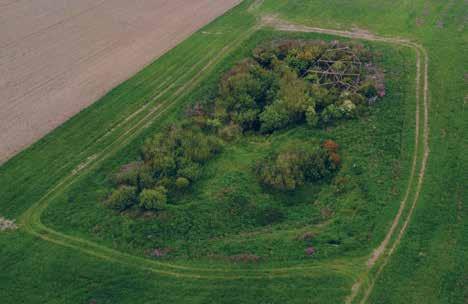
The thrill and skills developed safely ringing high volumes of migrant birds, even in a limited amount of cover, is hugely rewarding.
I simply love the idea of ringing birds that are undertaking amazing journeys and the prospect of uncovering data both in respect of that one bird’s life and, more widely, the value of stopoff locations on a flyway. This passion has taken me on overseas trips to ring spring and autumn warblers in the US, to sample the incredible spring passage in the Middle East and to catch Asian passerines in Mongolia.
In the UK, my main site has been at Buckton in East Yorkshire, an area of isolated coastal scrub on the north side of the Flamborough headland. Over the years I have planted new areas on the cliff top, built a wader scrape and a Heligoland trap – all aimed at increasing migrant-bird habitat and the number of birds recorded and ringed. Whilst my BBS results show that Buckton is a good site for breeding and wintering farmland species (I have ringed over 1,500 Tree Sparrows here) it is migrants that take centre stage.
In the past 20 years, I have ringed thousands of arriving migrants. Many of us like to see and process unusual birds and, at Buckton, this has included Yellow-browed Warblers (48), Red-breasted Flycatchers (six), Icterine Warblers (five) and, more
unusually, Radde’s Warber (two) and Dusky Warbler (two). In 2021, the site produced Yorkshire’s first Green Warbler. In short, Buckton has been operating like a bird observatory with fascinating recoveries adding to the UK picture. One September day saw four foreign controls from three different countries! It’s important to say that ringing is part of my overall life as a keen birder, so I always go out of my way to facilitate access for birders and thus showcase the BTO Bird Ringing Scheme in a positive light.
Due to a combination of factors, autumn 2024 also saw me operate at a new site, much closer to home. After studying maps, I set my goal on exploring the volume and diversity of migrant birds passing along an 80-m-high south-west-leading escarpment in south Cambridgeshire. The dry scrubby habitat surrounded by uniform arable agriculture looked interesting.
Ringing involved a CES-style arrangement of a fixed number of nets, operated for a set period of time on as many days as possible, and using playback lures to target species in key passage periods. In July, the catch was rather surprisingly dominated
by Acrocephalus warblers, with the nets full of Reed and Sedge Warblers on some mornings – a fact I would not have believed as I had rarely ever seen these species in the field at this location. Daily ringing produced a total of 22 new Grasshopper Warblers and then suddenly the ‘Acros’ peaked and dropped off, to be replaced with Sylvia warblers, especially Garden Warblers (71) in August and then Blackcaps throughout September (870 in total).
The volume of birds passing through was astounding for this tiny bit of habitat. At times it felt like an inland bird observatory – an impression helped by catching Redstarts, Tree Pipits and, pride of place, two Yellow-browed Warblers! Two thousand birds later I am shaking my head and smiling at the same time! I am pleased to have been involved this autumn in the inaugural Yellow-browed Warbler colour-ringing project, adding colours to six birds.
Finally, two things are clear, migrant birds are in huge trouble, and we have many passionate ringers who could help in a more co-ordinated way, with the targeted sampling of passage migrants and assessing the value of stop-off sites and habitats both on the coast and inland.
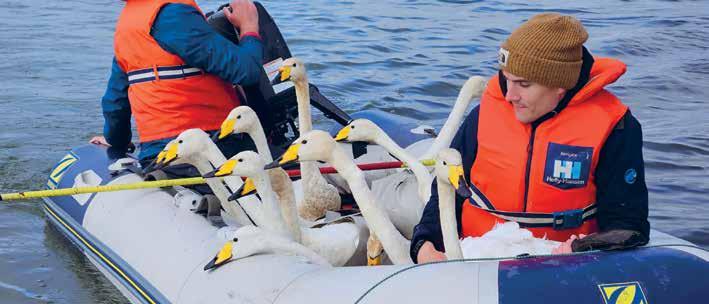
August 2023 saw the first fieldwork expedition of the new colour-marking study, with 480 birds caught; a further 216 were caught in 2024.
Where will you sleep? Will you be safe?
The Icelandic Whooper Swan has been intensively studied through a long-term life-history study led by the WWT in collaboration with Icelandic bird ringers, the Icelandic Institute for Natural History (IINH) and the Irish Whooper Swan Study Group. Commencing in 1989, the study saw several thousand birds ringed on the breeding and summering grounds in Iceland, and at wintering sites in Britain and Ireland. Kane Brides , Stephen Vickers and Scott Petrek explain how the study has evolved.
FURTHER READING
Brides, K. et al. 2022. Interchange of individuals between two Whooper Swan Cygnus cygnus populations, and its effect on population size estimates. Ringing & Migration 37: 1–12.
Brides, K. et al. 2021. The Icelandic Whooper Swan Cygnus cygnus population current status and long-term (1986–2020) trends in its numbers and distribution. Wildfowl 71: 29–57.
Soriano-Redondo, A. et al. 2023. Demographic rates reveal the benefits of protected areas in a long-lived migratory bird. Proceedings of the National Academy of Sciences, 120: p.e2212035120.
Wilson, J.C. et al. 2024. Using satellite tracking to assess the use of protected areas and alternative roosts by Whooper and Bewick's Swans. Ibis 167: 515–529.
In 2021, the WWT announced it would no longer be leading the Icelandic Whooper Swan study and, to prioritise work effort in other areas of wetland conservation, it exited from working on the species. This, twinned with a reduction in catching effort in Iceland, Britain and Ireland in recent years, has seen fewer colour-marked Whooper Swans in the population.
In an attempt to bolster the numbers colour marked, and to continue collecting data to contribute to the demographic monitoring of the population, we (the authors) have now taken the lead in catching and colour marking and, with the Waterbird Colour-marking Group, renewed effort with ring-reading data collection too.
Teaming up with Icelandic bird ringers led by Sverrir Thorstensen, collaborative effort sees targeted catching taking place of non-breeding moulting flocks in northern Iceland, along with catching family groups consisting of breeding pairs and their cygnets. A generous offer of collaboration with Prof Cao Lei of the Chinese Academy of Sciences, Beijing, saw us deploy 60 GPS tracking devices during the August 2024 expedition.
TRACKING STUDIES
There are many different aspects and outputs planned using these GPS data, with one strand in particular looking at the species’ roost-site choice, and to investigate the proportion of time the tagged individuals are protected by Britain and Ireland’s designated sites networks. These sites (i.e. SPA, SAC, SSSI, Ramsar) are one of the major tools used in species conservation, but birds are unlikely to always remain within these humandesignated boundaries (Wilson et al. 2024). With protected areas predicted to help double the population’s size by 2030 (Soriano-Redondo et al. 2023), understanding when and why a species chooses to use and not use protected areas can help us to improve the effectiveness of these management tools.
To assess roost site use by the GPStagged swans, nighttime was defined as data collected between one hour after sunset and one hour before sunrise, with these data used to help identify roosting sites. Once overlaid with boundaries of the various designated sites for Britain and Ireland, analysis of GPS data for October 2024
for the 38 tagged swans that had migrated overseas by then, showed that of the 692 ‘swan nights’ (one night for each swan per night) for which data were available, 376 (54.3%) nights were spent at protected sites, with 290 nights (41.9%) spent at non-protected sites; 26 nights (3.8%) were spent at both a protected and unprotected site. Delving deeper into where roosting at unprotected sites occurred showed that this mainly happened in England, especially in Cambridgeshire and Norfolk; however, important unprotected sites in Lancashire and Lincolnshire were also identified.
FARMLAND RESERVOIRS
The Ouse Washes is a 6,211-acre SSSI, SPA and Ramsar site stretching from near St Ives in Cambridgeshire to Downham Market in Norfolk. When flooded, this large wetland, twinned with the surrounding arable farmland, makes fenland very attractive to some 9,000 overwintering Whooper Swans (Brides et al. 2021). Dotted across the fens are small farm reservoirs used by farmers to store water for summer crops. GPS data from the tagged birds overlaid on satellite imagery showed that many of the unprotected sites being used by Whooper Swans roosting in England during October 2024 were in fact farmland reservoirs acting as alternative roost sites to the Ouse Washes; presumably being used as they are closer to daytime foraging areas. Combining GPS tracking data to identify roost sites with the use of thermal imagery, we are undertaking nighttime counts at these alternative roosts to understand better the use of these unprotected sites and, importantly, to determine the numbers of birds involved and how frequently these sites are used.
A wetland is considered internationally important if it regularly holds at least 1% of the individuals in a population of one species of waterbird, and a wetland in Britain is considered nationally important if it regularly holds 1% or more of the estimated British population. Counts in early November 2024 at just four of these unprotected reservoirs found that each held between 1% and 10% of the total population. Combined they held 20.8% of the entire Icelandic population, and 34.8% of the British wintering population!
Competition, foraging flight distances and flooding are likely factors determining where individuals roost each evening and, as the feeding distribution changes in relation to the annual harvest, so does roost-site selection. Large numbers of a population frequenting multiple unprotected sites or roosting at a single unprotected site in large aggregations is risky. Threats such as wetland pollution, poisoning and mass disturbance, especially at night, hold potential deadly consequences for large flying species like swans. Multi-season data collection and analyses using data collected across their wintering range will be undertaken to build up a picture of the swans’ use of roost sites in Britain and Ireland, and to assess how use changes over time and what may influence this. Further catches in Iceland to continue to increase the number of colour-marked birds will also be undertaken and resightings are, of course, always welcome!
COLOUR MARKS
Birds are being marked with white alphanumeric plastic rings, and an automated app at www. waterbirdcolourmarking. org collates resightings and sends observers instant life histories.
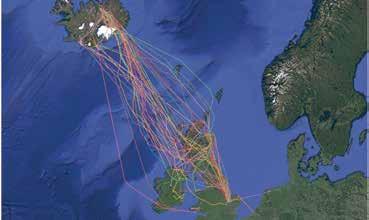

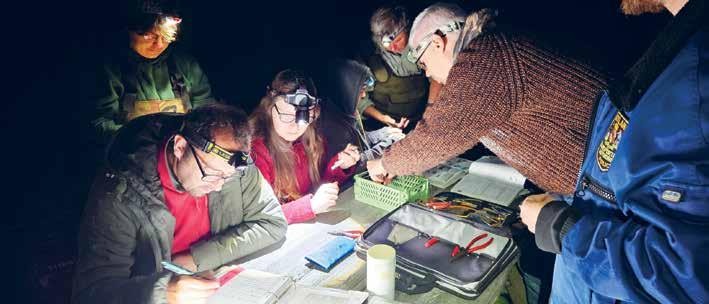
integral part of the assessment for some
applications
One year of modular permits
A year after implementing the modular permit system, requiring independent assessments for some endorsements, Mark Grantham and members of the Ringing Standards Select Committee (RSSC) reflect on what‘s gone well and what may benefit from more explanation.
LOWER-RISK ENDORSEMENTS
One of the key benefits of the modular system is that it allows Trainers to approve lower-risk endorsements, reducing turnaround times and allowing trainees to continue fieldwork unsupervised. For someone wanting to ring pulli and full-grown tits, as long as they’ve met the minimum threshold for those species, then the endorsements are approved on the recommendation of their Trainer. The same goes for A- and S-permit holders applying for lowerrisk endorsements – it’s just a quick approval based on their species totals. The system can also help to motivate trainees, as they feel they’re progressing faster, rather than waiting to get their C-permit with a mist-net endorsement. However, it’s important to still understand all the other elements of ringing, so whether you hold an unrestricted endorsement to mist-net passerines, or an endorsement to ring full-grown Blackbird (we have a number of permit holders who specialise in a single species, including Blackbird), you still also need to fully
understand the other aspects of ringing, such as access permissions, social-media guidelines, using DemOn, safeguarding and so on.
HIGHER-RISK ENDORSEMENTS
Higher-risk endorsements, such as mist-netting, require more scrutiny and now require an independent assessment to ensure demonstrable standards are met. The Scheme is under increased scrutiny from various angles, including the Statutory Nature Conservation Bodies that provide 40% of Scheme funding through JNCC. To show training is of the highest standard for these endorsements, an independent Trainer is asked to review the applicant. This independence is important; it’s not that we don’t trust the judgement of one Trainer, but that we need to have reviewed that applicant’s training. In the vast majority of cases, by the time a Trainer thinks their trainee is ready for an assessment then they will be just that. So having an assessment from a second Trainer just provides independent confirmation of this.
WHAT
IS INDEPENDENT?
We hope that people will follow the spirit of the guidance, not just the letter of the guidance. Is someone from your own ringing group that you spend 18% of your ringing time with (i.e. only just below the 20% maximum) really independent? An assessment should be seen as an opportunity to ring with someone new, as that’s how we share skills, knowledge, tips, and best practice. The assessment should be as much about sharing knowledge as evaluating an applicant.
WHY DO WE NEED SUCH COMPREHENSIVE
REPORTS?
The request for more detailed reports with applications can be seen as confusing and frustrating. Independent reports provide RSSC’s sole view of an applicant, or more accurately an assessment. It’s pointless to look at a report that just ticks the boxes, as RSSC are upholding Scheme standards as well as scrutinising individual applications. Hopefully this explains why some assessors are asked for more detail in
their report. Common mistakes include focusing more on someone’s ringing and processing experience than, for example, their mist-netting experience (when applying for a mist-net endorsement). Their Trainer can sign off on those other aspects (in the lower-risk full-grown endorsement), so the assessor should focus on mist netting. Another common error is not including enough detail about the actual assessment, which is needed to show RSSC that an assessment was thorough. “We opened two furled nets, caught four birds before it got too windy but the applicant seems fine” is clearly not sufficient, but equally “the applicant ringed with me for a morning and seems fine” says nothing about what was assessed. So please add that extra detail in your report, showing that the applicant, for example:
• managed a small team to erect four nets in dry scrub, including a dog-leg
• extracted 30 birds of a range of species, including a tongued Wren
• saw a rain shower approaching on a weather app, and took the decision to furl the nets furthest from base
• explained how at their own site they made sure that all nets were taken down or furled at the end of a session and whether this was foolproof.
MINIMUM THRESHOLDS
If minimum thresholds are not met, applications will be declined, as these are set for a reason. Thresholds are set at a reasonable level as tangible proof that someone has the experience for that endorsement. If you think thresholds are too high, contact us or your RIN representative to suggest a review. The system can evolve, as seen in recent changes to whoosh-net thresholds and pullus endorsements for waders and waterfowl. Remember that these thresholds are a minimum number, not a target, and your Trainer will determine when you are ready to operate independently based on a range of factors, including the number of birds you have ringed and processed.
A-PERMIT ASSESSMENTS
One big change is the key assessment shifting from the C–A upgrade to the T–C upgrade, as this is the big step to independent ringing.
That raises the question of what makes an A-permit holder? While some people would say ‘more experience’ or ‘the gold standard of ringing’, and to a degree some of that is true, the old Ringers’ Manual listed 17 A-permit criteria, of which 15 were also C-permit criteria. The two extras were knowledge of basic moult sequences and the ability to write a full plumage description, but that isn’t what makes an A-permit holder.
The difference probably IS about wider experience, but also in taking responsibility for your own actions and answering questions yourself that you previously asked your Trainer, such as:
• If I’m busy, when do I stop taking biometrics? Or do I just process retraps, migrants, adults, key species?
• Do I need to apply to a landowner for permission to ring on their land if it’s publicly accessible?
• Can I ring cygnets under my fullgrown waterfowl endorsement?
• How do I apply to colour ring and leg flag Lapwing chicks?
• Can I use ringing-group rings on my holidays?
These questions are likely answered somewhere in the guidance, but knowing when to ask and where to look for answers comes with experience. This is especially important when ringing on your own, as you need to make your own decisions; therefore, it is expected that C-permit holders looking to upgrade to an A permit have experience of ringing unsupervised.
UNSUPERVISED AND UNACCOMPANIED RINGING
Some ringers just don’t have the opportunity (or inclination) to ring solo, and in many ways we encourage ringers to operate in groups to build capacity for long-term projects. If
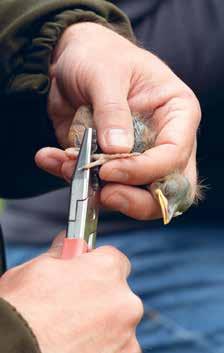
Passerine pulli is one of lowest-risk endorsements, reflected in the minimum threshold required for an application to be made.
you don’t have that solo experience, operating as ringer-in-charge of a group session, perhaps with no A- or S-permit holders present, can be equally useful. This involves planning sessions, dealing with trainees, making decisions about weather changes, dealing with unforeseen problems, data collection and so on. All of that experience is still valid, so if your unaccompanied ringing totals are quite low, your Trainer should explain that in the report, highlighting that you’ve run x number of group sessions as the ringer-in-charge.
S-PERMIT WITH NO TRAINEES
If upgrading to an A permit, please consider an S-permit assessment at the same time. Holding an S permit doesn’t oblige you to take on trainees, but allows you to act as an independent assessor, which is crucial for the modular permit system. By allowing different ringers to assess each other, we can maintain the high standards that we should be rightly proud of.
Introducing your new RIN members
Three new members have joined the Ringing Committee from 2025. Les Hatton, Holly James (C-permit representative) and Ellie Smart (T-permit representative) and each introduces themselves here. We would like to thank the outgoing members, Louise Clewley, Alex Phillips and Hayley Land, for all their contributions during their terms on RIN.
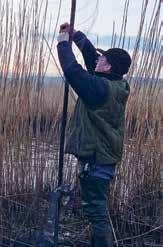
LES HATTON
I started as a trainee in 1987, moving to Scotland in 1988 where I benefited from the highly collaborative and supportive regional ringing-group structure. Originally starting with Lothian Ringing Group, I had an early opportunity as a trainee to be involved in the exciting and occasionally terrifying seabird monitoring programme. Moving to Fife, where I currently live, I’ve been an active member of the Tay Ringing Group since 1991, being inducted into the mysteries of cannon netting and reedbeds at an exciting time, when populations of Bearded Tit and Reed Warbler were only just establishing a toehold in the Tay Reedbed.
Thanks to the generosity and encouragement of many people in the Ringing Scheme, particularly in Scotland, I was able to undertake a wide range of ringing in great and inspiring company. On the way I became a cannon netter and
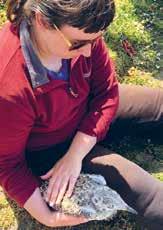
HOLLY JAMES – C-PERMIT REPRESENTATIVE
I started ringing with South Notts RG in 2019 and have held my C permit for two years.
In 2022, I was a grateful recipient of the first BTO Seabird Ringing Grant which enabled me to visit Skokholm for seabird experience. I proactively sought further opportunities and have visited the Isle of May, Portland, Dungeness, and the Shiants Isles since. This year, I’m looking forward to a trip to Bardsey for more seabird experience.
In 2023, ringing with John Callion and Colin McShane in Portugal inspired me to make my ringing more meaningful through single-species studies. This led me to start Europe’s first colour-marking project on Goldfinch to use coded colour rings, with a 51% resighting rate from 302 birds ringed so far. Naturally, this has developed into a study on eccentric moult (my favourite subject)! To determine if Goldfinches are moulting
a Trainer. I’ve had the good fortune to assist on a number of training courses, particularly the Catterick ringing course, as well as helping train people in Lesvos and Cyprus. Training others is a particular interest, mainly because I was lucky to ring in the company of some deeply inspiring people who gave freely of their time and experience. I’m fortunate in having some terrific T- and C-permit holders from whom I’m constantly learning.
Outside of ringing I started life as a factory worker, trainee psychiatric nurse, probation worker before finally managing to become a countryside ranger looking after the Eden Estuary for a terrific 17 years. Nothing stays the same though and, like many in the field, I became a consultant ecologist. I’m now trying to retire but continue to do some freelance work, mainly focusing on international projects.
more now than historically, I’m gathering data from museum collections to compare against present-day observations.
Using the BTO’s Demographic Targeting guide, I identified I could gather enough data for a Starling RAS. By the time you’re reading this, I’ll be wading through mealworms, operating a walk-in trap every day for an hour before work. Both studies take place in my garden; it’s amazing what data you can collect from birds on your doorstep.
As the C-permit representative, I hope to make the BTO’s scientific priorities more accessible to ringers at similar stages in their journey. My goal is to help facilitate meaningful data collection so the Ringing Scheme can better address critical population declines and inspire new generations of ringers.
Please get in touch if there’s anything I can contribute to the meetings on your behalf, or if you just want to talk about Goldfinches.

ELLIE SMART – T-PERMIT REPRESENTATIVE
I began my career as a photojournalist, but my fascination with the natural world, and the people working to protect it, soon led me down a different path. Initially, I took on marketing roles for wildlife charities, but a photography project on bird ringing unexpectedly changed everything. What started as a creative endeavour quickly became a full-blown passion, and I decided to leave my job and pursue ecology (and bird ringing) instead.
Four years later, I’m still a T-permit holder and completely bird-obsessed! I’m fortunate to be part of the North Cornwall Bird Ringing Group, where I’ve played a role in establishing the group. With a fantastic Trainer and a team of highly skilled C-permit holders, we’re involved in a wide range of projects, from Nightjar tagging and Willow Tit monitoring to Barn Owl ringing, the Winter Ringing Project and
Interesting snippets
BEHAVIOURAL NOTES ON DIPPERS
Steph Tyler shared this interesting note on Dipper behaviour:
Since the publication of the Poyser monograph The Dippers (Tyler & Ormerod 1997), some new observations have been made of the birds’ behaviour during the breeding season. This is largely thanks to observations made by two wildlife film cameramen, Robin Smith and Mick Jenner, who have been filming Dipper nests in Felicity Burge’s and my study area in the Wye Valley in Monmouthshire and Herefordshire.
One aspect of behaviour that may be of interest to nest recorders is that, immediately after juveniles fledge from a nest, the adults quickly remove the old nest lining of grass and leaves. This has been observed on at least five occasions. Possibly it is to get rid of the dirty lining in preparation for re-lining for a second brood, although not every pair has a second brood.
Of interest is that this same behaviour has been seen in Dippers in Mongolia and there, they do not have the time to have a second brood before
the rivers freeze over again (Andrew Lourie, pers. comm.). An alternative hypothesis is that the birds are cleaning bacteria and parasites from the nest in case they or their juveniles later roost in the nest.
Nest recorders checking on the success of a Dipper nest may deduce from the lack of lining that the nest has been predated, but this is not necessarily so. As nestlings grow, they usually turn round to defacate over the rim of the nest directly into the water below but, in some nests, adults still remove faecal sacs from well-grown young (>12 days up to fledging).
Finally, an anecdote on a nest Robin Smith and I were following as a site for a film on calls and song in birds, narrated by Sir David Attenborough. The female at the site laid a clutch and the eggs hatched successfully; I then ringed the brood at about nine days. Robin called a few days later to say that there were Dipper feathers on the bank near the nest and sure enough, the female had been killed and eaten, presumably by a Sparrowhawk. Sir
CES, lamping, nesting and, excitingly, our new Dipper RAS project (see page 14).
My background in photojournalism gives me a unique perspective on bird ringing. One of my biggest passions is communication, especially when it comes to capturing the ‘extraordinary’. And let’s be honest, anyone who willingly gets up at 4 am to put a ring on a bird is doing something truly remarkable!
As your T-permit representative, my aim is to help improve communication within the ringing community and find new ways to engage a wider audience. Ringing isn’t just a crucial tool for scientific research, it’s also a powerful way to inspire people to connect with birds in a handson, meaningful way. I’m excited to explore how we can grow together, strengthen our network, and encourage more people to play a part in protecting our avian friends.
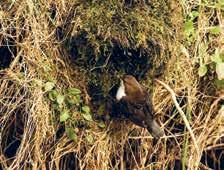
David was due to be filming at the nest less than a week later so we were quite worried that the male Dipper might give up. He proved to be a star and provisioned the young over the next 10 days or so (aided by mealworms put out by Robin!). When the film crew arrived, Sir David was able to rest on the bank near the nest and a shot was obtained of the male with food perched on a rock behind him and then flying past him to the nest. Happily, the young fledged successfully. During the week before fledging, Robin observed the male perched up on a bridge displaying, possibly to attract another mate!
RECOVERY FROM AVIAN POX
Justin Walker took this series of images of a Great Tit that recovered from avian pox. He writes:
Great Tit PT06275 was ringed as a healthy chick from a brood of five on 8 May 2024. On his first recapture on 26 October, it was unfortunate to note a medium-sized avian pox lesion had developed on his chin immediately below the lower mandible. I generally don’t recapture affected individuals, with the assumption that survival is limited. It was surprising then to catch this bird on six Winter Ringing Project visits, giving the opportunity to monitor the course of the disease and any impact on the bird’s health and physiology.
In summary, as the size of the lesion increased, the condition of the bird – as assessed through fat and muscle scores – decreased. When the lesion was at its largest, muscle score dropped to one, which is very unusual for a tit species outside of post-breeding moult. Weight remained surprisingly consistent (19.2 g – 21.5 g), but perhaps the weight of the lesion counteracts that lost through declining body condition.
One question might be how avian pox impacts body condition if, as in this example, the bird can feed unhindered? Given the size of the lesion seen in this case and that the lesion clearly has a blood supply, then there may be a greater energy requirement for thermoregulation, particularly as this bird was affected over winter.
Thankfully PT06275 survived, with no sign of infection present on his final capture on 2 February 2025. It would be interesting to know if there were other examples of birds surviving avian pox.
Editors’ note: there are some known examples of recovery from avian pox (see Further reading), but the photographic evidence of recovery is more unusual and shows how ringers can help not only with surveillance but also knowledge of infection and disease outcomes.
FURTHER READING
Lachish S. et al. 2012. Epidemiology of the emergent disease Paridae pox in an intensively studied wild bird population. PLoS One 7(11): e38316.
Lachish S. et al. 2012. Individual and population-level impacts of an emerging poxvirus disease in a wild population of great tits. PLoS One 7(11): e48545.
The progression of the avian pox lesion on (from top): 26 October 2024, 30 November 2024, 14 December 2024, 29 December 2024 and 17 January 2025.
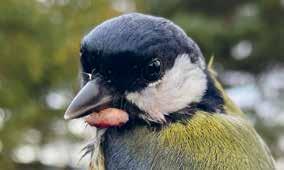
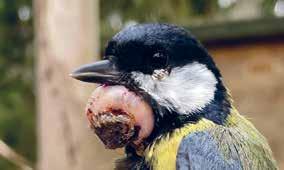
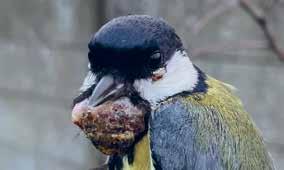
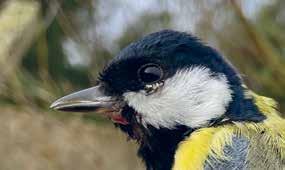
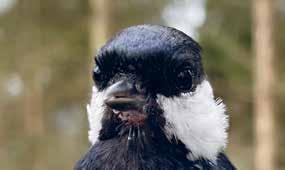
Obituaries
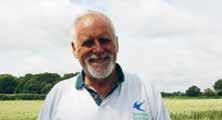
Steve Piotrowski was a passionate conservationist, dedicated environmentalist, and an avid bird watcher whose life and legacy continue to inspire those who knew him. Steve’s unwavering commitment to the environment left an indelible mark on the field of ornithology in the UK. A rare combination of birder, ringer, surveyor, and superb educator, Steve made significant contributions to both local and national ornithology. His surveying statistics are nothing short of remarkable. Between 2007 and 2011, he made an astounding 16,600 observations for the Bird Atlas, submitted over 148,400 observations to BirdTrack and, for 11 years, he diligently surveyed a Breeding Bird Survey square at Flixton Hall.

Countless birders and ringers over the past half century owe a debt of gratitude for the unstinting support from Bryan Galloway, who died suddenly, aged 81, on 17 February. With his incredibly deep knowledge, he helped so many in the field, at night classes, lectures, trips and ringing sessions. When he passed away, he was busy planning this spring’s Merlin and raptor work on his beloved Northumberland moors and, with his son Paul, organising their annual September raptor migration visit to southern Spain. Tyneside-born Bryan began as a schoolboy egg collector, developing nest-
One of the highlights of Steve’s educational efforts was his involvement in weekend courses at Flatford Mill. His participation greatly enriched the experience for attendees and his passion for sharing knowledge was evident in every interaction, inspiring countless individuals to develop a deeper understanding and appreciation for birdwatching.
Steve’s contributions to bird ringing were equally notable. He received his C permit back in July 1984, marking the beginning of a 40-year journey filled with dedication and enthusiasm. Many were inspired by Steve’s passion for birds and ringing through his various demonstrations and beginner courses. Over the years, he mentored 38 trainees, fostering a new generation of bird enthusiasts. In collaboration with Colin Carter, Steve played a crucial role in the formation of the Suffolk Community Barn Owl Project, responsible for the erecting of 2,000 nest boxes across the county. This initiative combined his influence, drive, commitment, and exceptional organisational skills, with
finding skills which proved invaluable when he and others, including myself, saw the error of our ways and began studying rather than robbing birds. A chemical engineer, he spent his career in the pharmaceutical industry. In 1958, with other young enthusiasts, he helped form the forerunner of the Northumberland & Tyneside Bird Club, becoming a longserving County Recorder and Chairman at a time when recording was the strict preserve of the Natural History Society of Northumbria. The powers-that-be took a dim view of the young upstarts, particularly when they produced a monthly bulletin and annual report. Bryan wrote the bulletin and most of the report and had in his attic a copy of every bulletin since the first single sheet.
With a great flair as a teacher and communicator, he was also a founder member of the Northumbria Ringing Group (NRG) and remained its secretary throughout. With the late Brian Little,
unwavering support from his wife, Kathy. The Suffolk Barn Owl Group made a significant contribution to Barn Owl ringing nationally, with nearly 5,800 birds ringed. Moreover, Steve was instrumental in establishing the Waveney RG. His knack for identifying new sites and collaborating with organisations like RSPB Minsmere, the National Trust, and local farmers has led to a group that has greatly impacted the monitoring of bird populations in the region.
Steve’s life was a testament to the power of passion, commitment, and community engagement in conservation. His legacy as a leader in ornithology and a mentor to many will continue to inspire future generations of bird watchers and conservationists. We will remember Steve not only for his contributions to the field but also his enduring spirit as a champion of nature. His impact will undoubtedly resonate in the hearts of those he inspired, reminding us all of the importance of preserving the natural world for future generations.
This obituary was prepared by Chris McIntyre
he discovered the site for the Group’s ringing station at Hauxley in October 1962, the tiny wood being "carpeted with Blackbirds". It was then a green oasis in a vast opencast-mining moonscape and therefore a huge attraction for migrants. The owner later donated the wood in exchange for an annual pot of Northumbrian heather honey, obviously the 20th century’s strangest land deal!
Bryan’s great love was being on the moors ringing Merlins, as part of a NRG study running since the 1960s. The work required great stamina and infinite patience and he had both in abundance. He passed on his knowledge to Paul who recently did most of the legwork. Much work involved the MoD’s vast Otterburn training area where Bryan was a longserving ornithological consultant.
Our sympathies go to Margaret, their children, Johanne and Paul, daughter-inlaw Jane and the wider family. This obituary was prepared by Ian Kerr
Using your data
This feature highlights some of the scientific papers that have been produced using the data that you collect through the Ringing Scheme or the Nest Record Scheme.
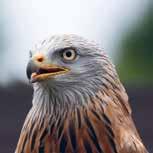
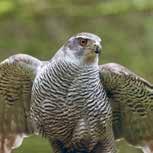
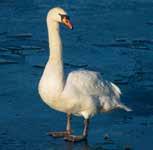
USING RECOVERIES TO ASSESS HPAI IMPACTS
Wild bird populations in the UK and Republic of Ireland were significantly impacted by High Pathogenicity Avian Influenza (HPAI) between 2021 and 2023, causing mass mortality particularly among seabirds and waterbirds. This paper assessed whether the reporting of ring recoveries from dead birds could provide a rapid way of assessing population impacts of HPAI across multiple species. Data from ring recoveries relating to 58 species, found dead between October 2021 and March 2023, were compared to baseline recovery trends from 2010/11 to 2020/21 (before the recent HPAI outbreak). Excessive ring recoveries were found in 14 of the species investigated: one raptor (Red Kite), eight seabirds (Black-headed Gull, Common Tern, Sandwich Tern, Gannet, Great Skua, Guillemot, Herring Gull, Kittiwake) and five waterbirds (Curlew, Gadwall, Lapwing, Mute Swan, Woodcock), with these increases being most striking in seabirds. The study concluded that ring-recovery data can rapidly indicate excess mortality occurring within a population and rapidly estimate annual mortality rates to aid quantification of the impact of HPAI. Meaningful estimates of excess mortality are most likely where the distribution of ringed birds and search effort are evenly spread across populations.
Johnston, D. T. et al. 2025. Using ring (band) recovery data to examine the impact of high pathogenicity avian influenza (HPAI) on wild bird populations. Bird Study: doi: 10.1080/00063657.2025.2491797
POST-FLEDGING MOVEMENTS OF GOSHAWKS
Goshawks in the UK have recovered from near extinction to number around 1,200 pairs; however, these are distributed at a lower density than in neighbouring European countries, where they utilise a wider variety of habitats than here. In the UK, Goshawks are mostly found in forest habitats, but this could change if populations rise to carrying capacity. In this study, 29 GPS-GSM tags were fitted to Goshawk chicks from 22 nests in Norfolk, Suffolk and Gloucestershire to try to understand their post-fledging movements. The results showed that first-winter birds occupied a small (c. 5 km) home range in the periphery of their parents’ breeding habitat; these ranges were associated with mixed, open habitats by forest edges with farmland or were entirely associated with farmland (the latter particularly so by male birds). The difference in habitat preference between the sexes might be due to the prey types available to the differently sized birds. As the young birds matured, they shifted their habitat towards the denser forests associated with their parents. The study concluded that range expansion out of forest habitats might take time but is probable given the young birds’ ability to utilise non-forest habitats.
Henderson, I. et al. 2025. Post-fledging movements in an elusive raptor, the Eurasian Goshawk Accipiter gentilis: scale of dispersal, foraging range and habitat interactions in lowland England. Ibis: doi.org/10.1111/ibi.13403
RELIABILITY OF COLOUR-MARK SIGHTINGS
This study aimed to assess how reliable colour-mark sightings made by community scientists are, when compared to systematic recording methods. Mute Swans have been monitored and colour-marked around Lincoln city centre since 2017. Since 2020, 90 community scientists signed up to the Lincoln Swan Project. They were given guidelines on how to record swan sightings via an app and were asked to record various bits of information including the ring number (if known), number of individuals (by age group), whether the bird was on a nest and, if so, whether there were eggs or cygnets present (and how many), and whether the observer fed the swan(s). Researchers compared 5,251 community-scientist sightings with 317 observations recorded through systematic recording methods. The results showed that 98.9% of ring readings were correctly reported; sighting reliability increased with experience and was higher when the observer fed the birds. Community scientist observations were reliable for quantifying family-group size but not clutch size. Community science data can be reliable for colour-ringing projects involving large birds but the study highlighted the need to validate results before using them to inform wildlife management and conservation practices.
Maréchal, L. et al. 2025. Community science as a potential tool to monitor animal demography and human–animal interactions. Scientific Reports 15: 2730.
Noticeboard
RINGING COMMITTEE 2025
RIN meets twice a year, usually in spring and autumn. Agendas, non-confidential papers, minutes and members’ contact details are available on the Ringing Hub (www.bto.org/ringing-hub). Members are happy to receive correspondence throughout the year, either directly or via rin@bto.org
COMMITTEE MEMBERS
Lucy Wright (Chair) – Cambridgeshire
Richard du Feu – Lancashire
Helen Franklin – Warwickshire
Les Hatton – Fife
Peter Kirmond – Gloucestershire
Jim Lennon – Nottinghamshire
Stephen Vickers – Midlothian
Roger Walsh – Norfolk
Holly James – Notts (C-permit rep)
Ellie Smart – Cornwall (T-permit rep)
POTTER TRAPS FOR SALE
Two sizes (12” & 16”), also Chardonneret and other traps on request. Please contact John Mawer on 07502 221078 or via email johnrmawer@ hotmail.com
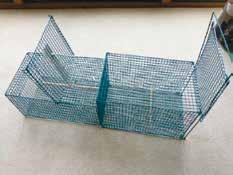
CONTACTS
Nest Record Scheme: nrs@bto.org
Ringing Scheme: ringing@bto.org
Constant Effort Sites: ces@bto.org
Retrapping Adults for Survival: ras@bto.org
Colour ringing: colour.ringing@bto.org
DemOn queries: apps.demon@bto.org
Licensing: ringing.licensing@bto.org
Schedule 1: ringing.schedule1@bto.org
Special Methods: ringing.specialmethods@bto.org
Ringing sales: sales@bto.org
CONFERENCES
Scottish Ringers’ Conference
7–9 November 2025 (Friday evening to Sunday lunch time)
Location: Carrbridge Hotel, Scottish Highlands
This year’s conference will be hosted by the Highland Ringing Group. More information to follow.
The North of England Raptor Conference
Saturday 15 November 2025
Location: The Glow Venue, Newton Aycliffe, County Durham
The full programme and booking arrangements for delegates will be available in early August via the NE Raptor Forum website (https://raptorforum. wordpress.com/conference/)
Southwest Ringers’ Conference
Saturday 31 January 2026
Location: WWT Slimbridge Wetlands Centre
This event will be hosted and supported by WWT More information to follow.
LICENSING CALENDAR
Jan–Mar — individual ringing permit renewal Feb — ringing groups renewal
28 Feb — deadline for ringing data from previous year
31 Mar — unrenewed permits expire May — ring refunds / rebates paid
31 Dec — deadline for receipt of Schedule 1 renewals, Special Methods reports, colour-ringing reports and renewals
THE 2025 CES VISIT PERIODS
Monitoring priorities: Sand Martin
The Sand Martin is our smallest hirundine, and one of the earliest summer migrants to arrive in the UK. The species moved from the Amber List of the Birds of Conservation Concern to the Green List in 2015, thanks to recent population recoveries.
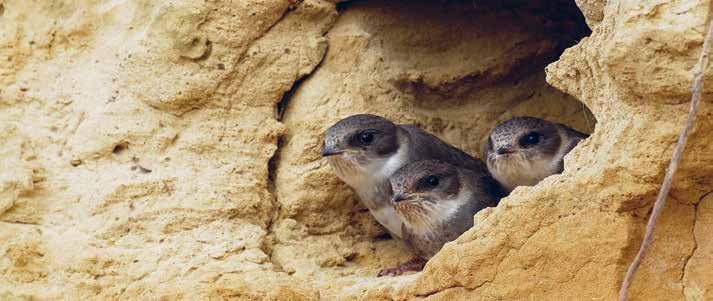
CURRENT KNOWLEDGE
Sand Martins are a difficult species to monitor, thanks in part to difficulties distinguishing active versus inactive nest holes. Colonies are also prone to disperse or shift location as sand cliffs collapse. Populations of Sand Martins have been fairly stable since 2003, though populations monitored through the Waterways Bird Survey and Waterways Breeding Bird Survey declined enough in the 1990s to be of some concern. Monitoring through BBS shows that the population exhibits large fluctuations; however, it has been difficult to establish a long-term trend. Severe population crashes have occurred over past decades, likely due to drought in wintering areas, but these have usually been followed by a degree of recovery. The creation of artificial
banks and nest holes can be effective in attracting breeding Sand Martins and provide access to nest holes for ringing and nest-recording purposes.
HOW CAN YOU HELP?
Start a RAS project
We currently have 10 active Sand Martin RAS projects. Birds can be caught with nets when leaving their holes, either in the morning or evening, from artificial or natural banks. It is important to ensure you have enough ringers to extract birds from the nets in a timely manner, particularly given the numbers that can be caught in a large colony. If you have access to an artificial bank, or funding to create one, a successful RAS project can also be combined with nest records, supplying even more valuable data. A lot of very
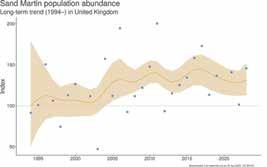
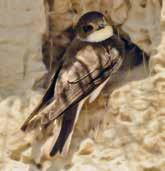
useful information for monitoring this species can be found in the Sand Martin guidance (available on the Species Pages) in the Ringing Hub.
Collect nest records
The number of nest records received has increased over the last decade, up to 1,162 records in 2023, considerably higher than a decade earlier (506 records in 2013). Monitoring natural nests has always been fairly challenging, though once found, monitoring with an endoscope is possible. Sites with large colonies will usually be known, or easy to find due to the number of adult birds present, but smaller sites are also useful to collect data from. In recent years, the increasing use of artificial banks and nest holes has made nest monitoring significantly easier.
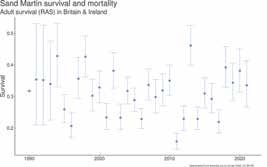
Graphs shown are taken from the BTO Trends Explorer (http://data.bto.org/trends_explorer), where results from the Ringing and Nest Record Schemes are published annually, alongside census data. Image by Philip Croft.
